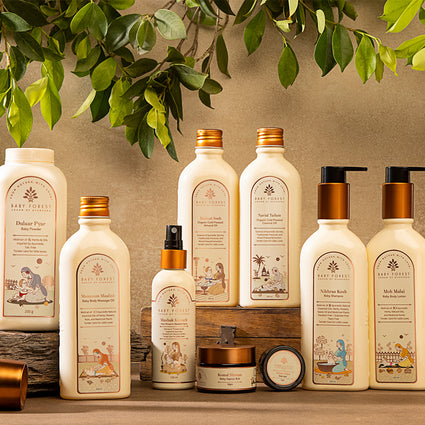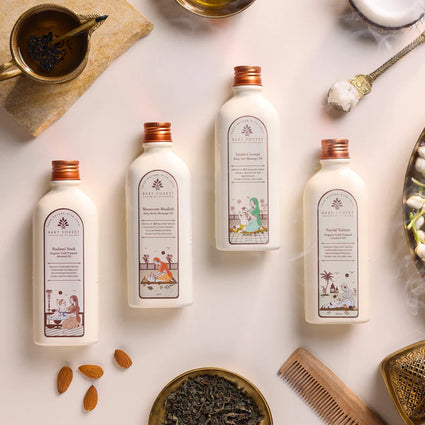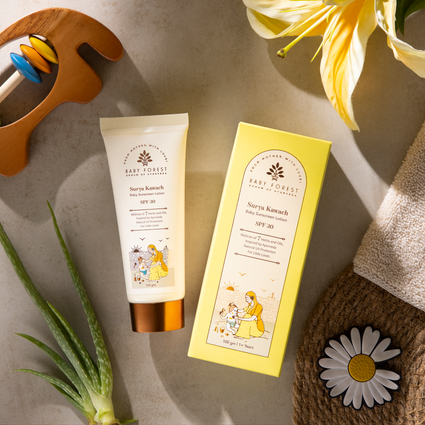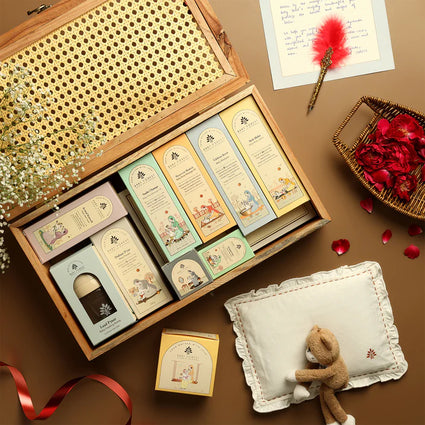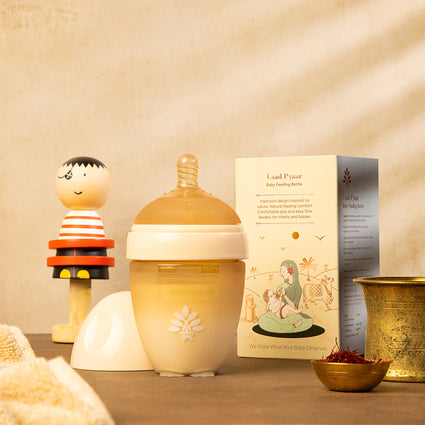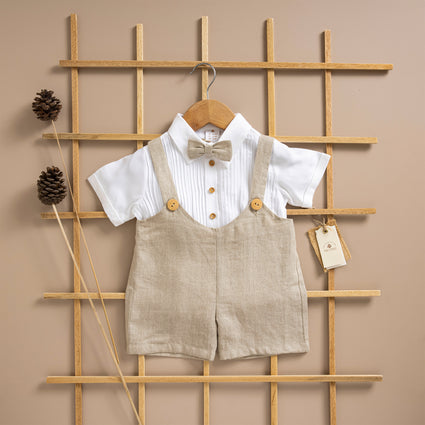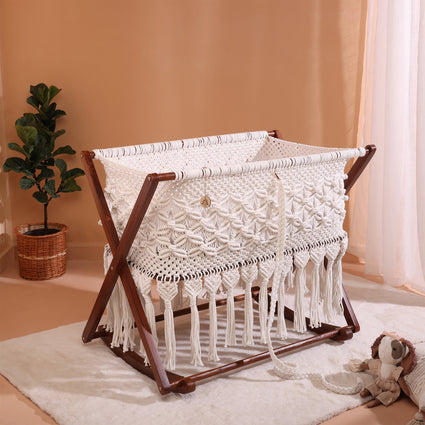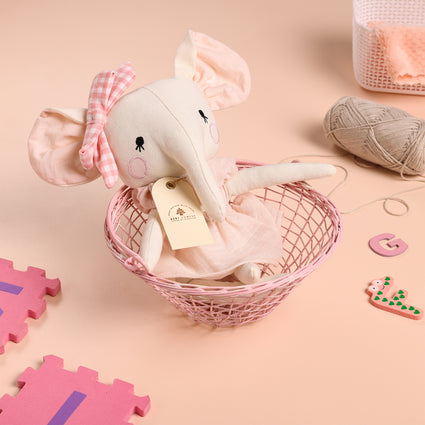Baby Care & Parenting Blogs

Celebrating the Energy of Motherhood: An Essence of Joy &...
Motherhood is a beautiful and lifelong journey filled with love, joy, and unforgettable moments. Celebrating motherhood means acknowledging the hard work, dedication, and love that mothers pour into raising their children. It's a celebration of the unique bond between a mother and her child, a connection that starts from the very first heartbeat and lasts a lifetime.
Embracing New Motherhood
For new moms, the journey into motherhood is filled with a mix of emotions, from overwhelming joy to occasional uncertainty. These first few months are crucial as they adapt to their new roles and learn about their baby's needs and personalities. Celebrating new mothers involves recognizing their initial steps into parenting, which are often as challenging as they are rewarding. Providing support, understanding, and encouragement during this transformative period is essential in helping them feel confident and cherished in their new role.
The Unique Bond Between a Mother and Child
The relationship between a mother and her child is unlike any other. From the moment of birth, mothers and their children share a deep emotional connection. This bond is built on endless moments of care, affection, and understanding. A mother often understands her child's needs and emotions, sometimes even before the child expresses them. This unique connection is not just about biological ties; it's about the countless sacrifices, endless support, and unconditional love that define motherhood.
The Challenges of Motherhood
Being a mother is one of the most rewarding roles, but it's not without its challenges. Mothers often juggle multiple responsibilities, from managing the household and caring for their children to maintaining a career and personal interests. Despite these challenges, mothers consistently demonstrate resilience and strength. Their ability to manage these tasks contributes greatly to the essence of motherhood, showing their children a model of perseverance and dedication.
How to make Mother's Day Special?
Celebrating mothers should be more than just a one-day affair; it should be a continuous appreciation of all they do. Here are a few ideas to make mothers feel special:
-
Spend Quality Time Together:
Organize a day out or a special meal at home. The gift of time is often the most cherished. -
Create a Handmade Gift:
A personalized gift, like a handmade card or a photo album, can hold special meaning. -
Gift Certificates:
Whether it's for a spa day, a favorite store, or a cooking class, a gift certificate can give mothers a much-deserved break or a chance to pursue their interests. -
Help Out:
Offer to take over some of her daily tasks. Sometimes, the best gift is a day off from usual responsibilities.
Gift Ideas for New Moms
When thinking of gifts for new moms, consider items that add comfort to their lives or simplify their new routines:
-
Nursing Pillows and Accessories:
These can offer much-needed comfort and support during feeding times. -
Pampering Kits:
A basket filled with spa essentials like lotions, bath salts, and soothing teas can offer a new mom a peaceful retreat at home. -
Baby Cradle:
A comfortable and safe cradle can be a sanctuary for a newborn, ensuring they have a cozy place to sleep. -
Feeding Bottles:
High-quality feeding bottles that are easy to clean and safe for the baby can be a practical and thoughtful gift. -
Baby Clothes:
Soft, comfortable, and easy-to-wear baby clothes that makes frequent changes easier can also be a fantastic gift option.
The Importance of Mothers in Family and Upbringing
Mothers play a crucial role in the upbringing of children and in the family's stability. They often serve as the heart of the household, offering emotional support and guidance to everyone. The influence of a mother in her child's life is profound and far-reaching, affecting their emotional growth, learning, and overall development.
The essence of motherhood is made up of joy, challenges, and an unbreakable bond between mother and child. Celebrating this essence not only honors mothers but also acknowledges their fundamental role in shaping the next generation. So, take the time to celebrate and appreciate the mothers in your life, not just on special occasions but every day. Their impact is priceless, and their role is irreplaceable.
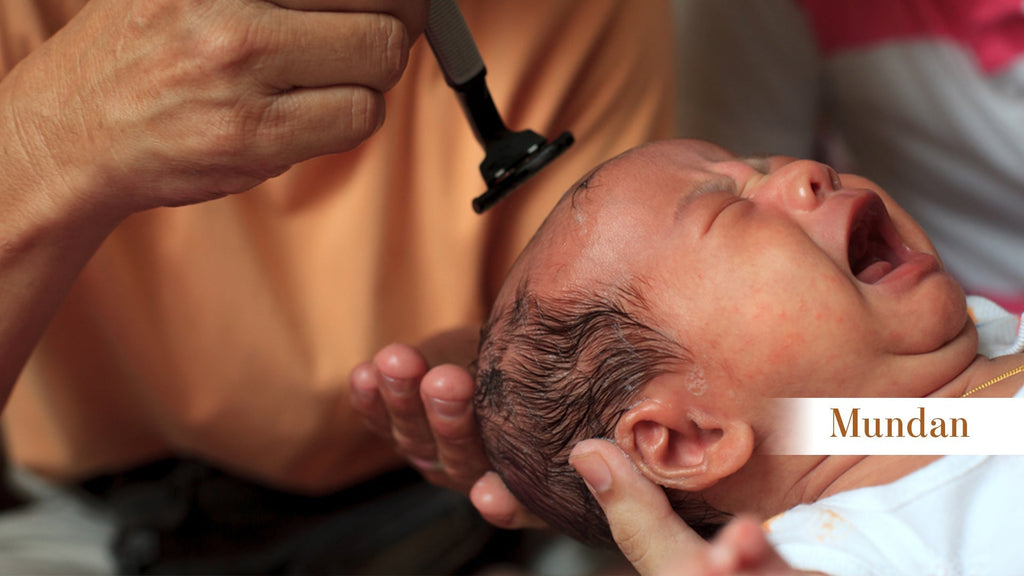
Mundan Ceremony: The Baby's First Haircut
The first things related to babies are always extraordinary and special. And in Hindu culture, the first haircut is primarily ceremonious. Commonly known as Mundan, the ritual is called choodakaran or chaul in some parts of India.
According to Ayurveda, the ritual of mundan is believed to help regulate the body's temperature and maintain cerebral balance, thus promoting better and healthier growth. The act of shaving the head is also thought to open the crown chakra, enhancing the body's energy flow, which is vital for mental and physical health. Additionally, Ayurveda suggests that this practice can remove impurities and past karma, potentially improving the child's well-being.
What is the Mundan Ceremony for Babies?
The Mundan ceremony is a special event/ritual for babies in some cultures, particularly among Hindus. It involves shaving off the baby's first hair, usually when they are around one to three years old. People believe this ceremony cleans the baby from their past life, protects them from evil, and blesses them with a good future. Family members, friends, and a priest usually gather to celebrate this occasion with prayers and blessings. The Mundan is both a religious ritual and a joyful family gathering, marking an important milestone in a baby's life.
When And How Should You Do Mundan?
Ideally, the ceremony should be performed from the first year till the third year of a baby. The time is correct because the child is not as delicate as a newborn. In exceptional cases, parents can do the mundan later as well. But, doing the mundan at an odd number of months and years is suggested. It can be done at 7, 9, or 11 months of age. Some families follow the auspicious time indicated by the priest.
On the day of the ceremony, a havan is performed by the priest. The mother holds the baby in her lap. The priest shaves a small amount of hair first. Then, the barber continues to shave the rest. Following the hair cutting ceremony, sandalwood and turmeric is applied on the baby's head. This protects the baby's head from infections, heals the cuts, if any, and Chandan cools down the temperament.
Where is the Mundan Ceremony Performed?
The Mundan ceremony can be performed in various locations depending on family traditions and preferences. Commonly, it takes place in a religious setting such as a temple, which provides a sacred environment for the ritual. However, some families choose to hold the mundan ceremony for their baby boy or girl at their home for a more intimate setting, especially if they wish to include only close relatives and friends. In some cases, it may also be conducted at a pilgrimage site or a significant religious place, adding spiritual significance to the event.
Is Performing Mundan Important for Your Baby?
Every ceremony in traditions has some deeply rooted significance. Some of them are scientific, and some of them are logical beliefs. Here are the benefits of Mundan:
- It marks the beginning of a new life and removes any negativity from the past life.
- It plays a very important role in healthy hair growth.
- It helps the baby during teething by toning down the pain.
- It marks the learning of cleanliness for a child.
- It supports the development of nerves in the brain
- It provides coolness in summer.
Precautionary Tips for a Safe Baby Mundan Ceremony
- Be gentle to your baby. Let them rest well before the ceremony.
- The person doing the mundan should be well trained for it.
- In the case of the salon, avoid having a mirror in front of a baby. It might not be pleasing for them to see, and they can feel terrified by the image.
- Don't make the ceremony crowded. Even though some people choose to do a grand celebration, it might be too overwhelming for a baby.
- Instruments like razors or scissors should be sterilized and cleaned.
Some parents choose to perform the Mundan Ceremony at the holy places of Ganga Ghats or temples. In contrast, some of them conduct the ceremony at home. These days mundan is also conducted at salons. Wherever it is, Mundan is one of the most important Sanskar out of sixteen Sanskaras in Hinduism. Every strand of hair is kept to be offered to the deities. In some traditions, they are immersed in the holy river Ganga.
Related Read - 5 Baby Rituals That Every Parent Should Know
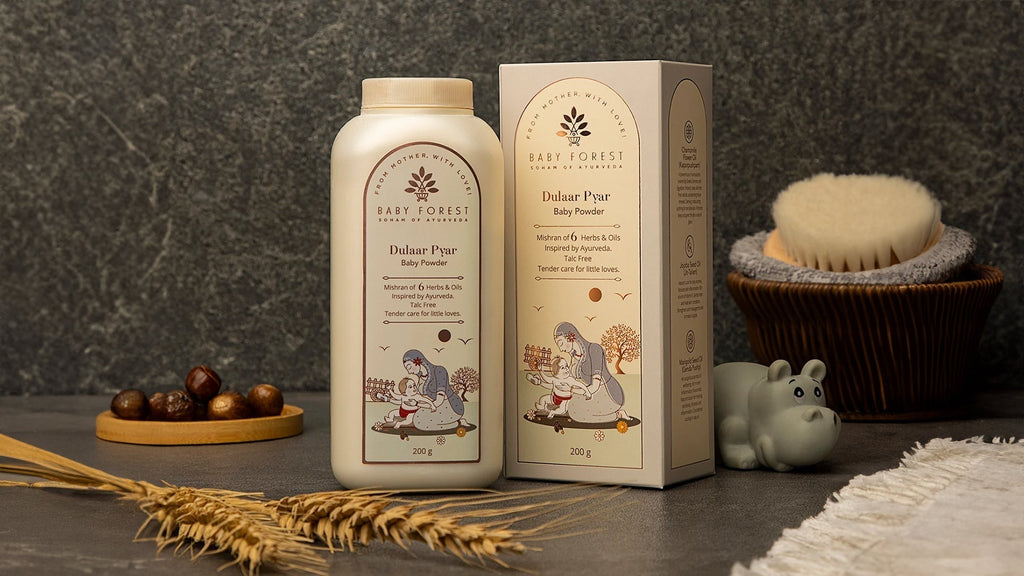
Why Talc-Free Baby Powder is a Must for Summer Heat?
As temperatures soar during the summer months, keeping the little ones comfortable becomes a priority for every parent. An essential item in many households is baby powder, especially to combat the heat and humidity that can cause discomfort and skin rashes in babies. However, the type of baby powder you choose is crucial. In this blog, we'll explore why talc-free baby powder is a safer and healthier choice for your baby during the hot season.
All About Talc and Its Concerns
Traditionally, a lot of baby powders used to have talc in them, which is basically made up of magnesium, silicon, and oxygen. Talc is popular because it's really good at soaking up moisture and reducing friction that causes chaffing , which is why it was often used in baby powders and other beauty products. However, there have been a few concerns about talc's safety over the years. The main issue is its potential contamination with asbestos, a known carcinogen, and the risk of respiratory problems if infants inhale the fine particles.
In light of these concerns, many parents and health experts advocate for the use of talc-free products, particularly for babies who are more vulnerable to the adverse effects of these particles.
What is Talc-free Baby Powders?
Talc-free baby powders are a gentle alternative to traditional baby powders that contain talc, a mineral known for its moisture-absorbing properties. Instead of talc, these powders use natural, plant-based ingredients such as Cornstarch, Chamomile Oil, and Oats Kernel, which are equally effective at keeping moisture at bay without the associated health risks of talc, such as potential contamination with asbestos and respiratory issues from inhalation.
Benefits of Talc-Free Baby Powder
-
Safer Ingredients:
Talc-free baby powders are usually made with cornstarch or other plant-based ingredients like aloe vera. These natural alternatives are gentle on the baby's sensitive skin and are free from asbestos risks. -
Prevents Rash:
During summer, the risk of rashes increases due to the heat and humidity. Talc-free baby powders absorb excess moisture naturally, keeping the baby's skin dry and comfortable, thereby preventing rashes. Additionally you can use Rash Healing cream. -
Avoids Respiratory Risks:
The particles in talc-free powders are generally larger and less likely to be inhaled than those in talc-based powders. This reduces the risk of respiratory problems, which can be serious for children. -
Natural Skin Care:
Many talc-free powders contain additional natural ingredients that benefit the baby's skin. Ingredients like aloe vera and chamomile can help soothe the skin and prevent irritation, making them ideal for use in sensitive diaper areas during the hot months.
Choosing the Right Talc-Free Baby Powder
When selecting a talc-free baby powder, look for products that are:
-
Natural:
Ensures that the product is free from harmful chemicals and genetically modified organisms. -
Artificial Fragrance-Free:
Added fragrances can irritate a baby's delicate skin. Opt for products with no added fragrance to avoid potential allergens. -
Derma Safe:
Choose products that are derma-safe and approved for use on sensitive skin.
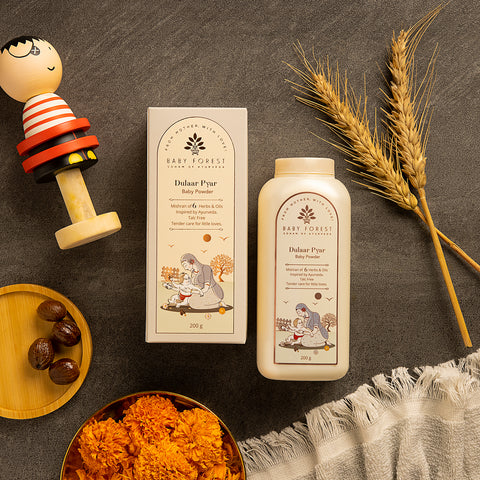
How to Use Talc-Free Baby Powder Safely
To maximize benefits and minimize any risks, even with talc-free powders, it's important to use baby powder correctly:
-
Apply Sparingly:
Use a small amount of powder and keep it away from the baby's face and eyes to avoid inhalation. -
Direct Application:
Apply the powder directly to your hands, away from the baby, and then to the baby's skin. This method helps to control the amount of airborne particles.
Talc-free baby powder is a much safer and healthier option for summer baby care. By incorporating talc-free baby powder into your daily routine, you can ensure that your baby enjoys the summer safely and comfortably. With natural ingredients that are gentle on the skin and effective at moisture absorption, talc-free powders can help keep your baby dry, comfortable, and happy during the hot weather. Always opt for natural, cruelty-free, and derma-safe products to ensure the best care for your little one's delicate skin. Enjoy a worry-free summer with the right products for your baby's needs! Whether at home or on the go, this simple change can make a big difference in your baby's well-being during the warm season.
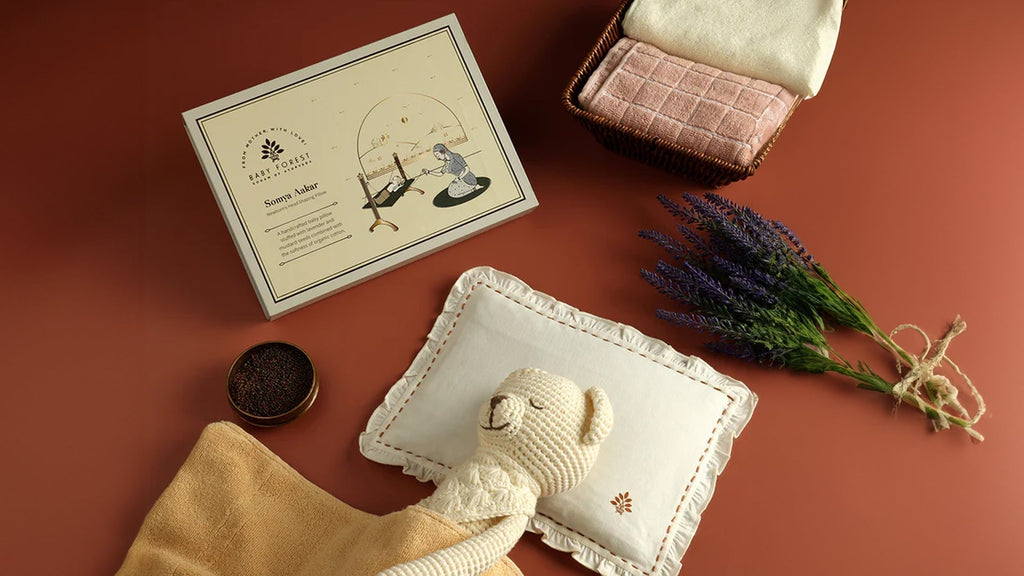
A Comprehensive Guide To Choose The best pillow for your ...
When you welcome a new baby into your home, every little decision can seem overwhelming, especially when it comes to ensuring their comfort and safety. One such decision is choosing the right pillow for your newborn. With a myriad of options available, it's crucial to select a pillow that not only provides the necessary support but also aligns with your baby's health and developmental needs. In this guide, we'll explore why the mustard seed pillow is considered one of the best choices for newborns and also understand its numerous benefits.
Understanding your Newborns' Needs
Before we discuss the specifics of pillows for newborns, let's discuss why newborns need different support than older babies and adults. Newborns have delicate structures, including their neck, spine, and head. They require a pillow that supports natural posture, prevents flat head syndrome, and ensures a safe & comfortable sleep environment. The choice of pillow can significantly impact their well-being and development during these critical early months.
Mustard Seed Pillow for Newborns: An Ancient Solution
The mustard seed pillow is not a new invention but rather a traditional solution that has been used for generations in many cultures around the world. This type of pillow is filled with tiny mustard seeds, which provide a firm yet adjustable surface for your baby's head. The flexibility of the mustard seeds allows the pillow to mould perfectly to the shape of your baby's head, providing support without unnecessary pressure.

Benefits of a Mustard Seed Pillow for Newborn
-
Prevents Flat Head Syndrome
One of the most significant benefits of using a mustard seed pillow is its ability to prevent the development of flat head syndrome. This condition, known as plagiocephaly, develops when a baby's head flattens because of sustained pressure on a specific spot. The malleable nature of the mustard seed pillow helps distribute pressure evenly around the baby's head, reducing the risk of flat spots.
-
Natural and Safe:
Mustard seeds are completely natural and non-toxic, making them a safe filling for newborn pillows. Unlike synthetic materials, mustard seeds do not emit harmful chemicals that could irritate your baby's sensitive skin or respiratory system.
-
Supports Neck and Spine:
One of the standout benefits of the mustard seed pillow is its exceptional ability to support the delicate neck and spine of a newborn. The unique structure of the mustard seeds allows the pillow to conform naturally to the shape of the baby's head, guaranteeing that the neck and spine maintain a neutral alignment. This alignment is crucial for preventing any strain on these developing areas and promotes a healthy posture from an early age. By distributing the baby's head weight evenly, the mustard seed pillow reduces the risk of common issues like flat head syndrome while simultaneously providing the necessary support for the neck and spine
-
Durable and Long-lasting:
Mustard seed pillows are incredibly durable and can last for many years if properly cared for. They do not lose their shape or support over time, unlike foam or feather pillows, which can become lumpy or flat.
Related Read - Mustard Seeds Pillow Benefits: Ideal for Your Newborn's Comfort and Health
How to Find the Ideal Newborn Pillow?
The ideal newborn pillow should be firm enough to support the baby's head yet soft enough to prevent any undue pressure that could lead to flat spots. It should be made of natural, breathable materials to maintain a comfortable temperature and be adjustable to cater to the growing baby's needs. A mustard seed pillow embodies these characteristics perfectly, offering a traditional yet effective solution for newborn sleep comfort.
Care and Maintenance
Caring for a mustard seed pillow is straightforward. Regularly airing the pillow and exposing it to sunlight can help maintain its freshness and prevent moisture buildup. The pillow cover should be washable for easy cleaning. You should keep checking the pillow regularly for any signs of wear and tear to ensure it remains safe and effective for use.
Conclusion
Choosing the best pillow for your newborn is a critical decision that can affect their comfort, safety, and development. The mustard seed pillow, with its natural, adjustable, and supportive properties, stands out as an excellent choice for many parents. By understanding the benefits of a mustard seed pillow and knowing what to look for when choosing one, you can provide your baby with a comfortable, supportive sleeping environment that promotes healthy growth and development. Remember, every baby is unique, so it's essential to consider your child's specific needs when making your selection. Here's to peaceful nights and healthy babies!

Annaprashan: The First Meal Of Your Baby
Welcoming a new baby into the world comes with many cherished moments and milestones. One such significant event in many cultures, particularly among Hindus in India, is the Annaprashan ceremony. This traditional ritual celebrates the baby's first introduction to solid food.
What is Annaprashan Ceremony?
Anna means grain, and prashan means feeding. Annaprashan, also known as the rice ceremony, signifies the initiation of feeding grain to a baby. The same ceremony is known as Bhat Khulai in Himachal Pradesh, Choorunu in Kerela, and Mukhe Bhaat in West Bengal. Ancient Religious Hindu Text Smriti describes it as one of the most important sanskaras out of sixteen rites.
Why Is Annaprashan An Important Ceremony?
Food is vital to human existence. We are complete when we eat and the cycle goes on for the rest of our lives. But an introduction to feeding a newborn is a steady process. Annaprashan is scientifically essential as it introduces the baby to the guide to get the required nutrients they cannot get from breastmilk, and they must learn to feed on solid food.
When Should You Perform Annaprashan?
The date for Annaprashan is usually based on the baby's health and the Hindu lunar calendar to ensure it falls on an auspicious day. Culturally, Annaprashan is performed four to six months after birth. It is auspicious to do the Annaprashan ceremony for baby girls on odd months like five or seven, and even ones are auspicious for boys. Before six months, it might be dangerous to feed solid food as their immunity is low, and they might find it difficult to digest.
Types of Food Offered to the Baby During the Ceremony
During the Annaprashan ceremony, the primary type of food offered to the baby is usually a soft, well-cooked rice-based dish. This is often in the form of a sweet rice pudding known as 'kheer' or 'payesh' in various parts of India. The rice is cooked with milk and sugar, making it easy for the baby to digest. In some families, the first food might also include mashed fruits like bananas or cooked vegetables like sweet potato, depending on regional traditions and family preferences.
What are the Rituals Followed in Annaprashan?
The annaprashan ceremony can take place at home or in a temple, depending on the family's preference and the significance they attach to the location. Temples are often chosen for the spiritual ambience and the presence of a priest to conduct the ceremony with traditional rituals.
Every culture has beautiful details about the ceremony, followed by family customs. Some of them are common to all. For instance, feeding rice pudding or kheer is standard, while bathing a child in sandalwood and turmeric is critical to Bengali culture. Children get dressed in traditional ways, followed by being fed by their father, grandfather, or maternal uncle. Everyone at the ceremony feeds some amount of food to the baby and puts rice and grass on the baby's head.
During the Annaprashan ceremony, there's a ritual followed by the rice feeding ceremony where the baby is presented with a variety of objects like a book, pen, clay, money, silver plate, and food placed around them. It is exciting to see which item the baby will reach for first. It's believed that the object the baby chooses can hint at their future interests or careers. For example, if the baby picks up a pen, it might suggest they have a love for writing or learning. If they grab a coin, it could mean they'll be good at managing money.
The presence of friends and family makes the ceremony memorable for child and their friends. But it might be too immense for your Lil one. Keep your guest list short and precise. Even though it's a part of the ceremony, the child might feel moody and cranky since everyone is feeding them. Give them some space and remember to make fun memories.
Related Read - 5 Baby Rituals That Every Parent Should Know.
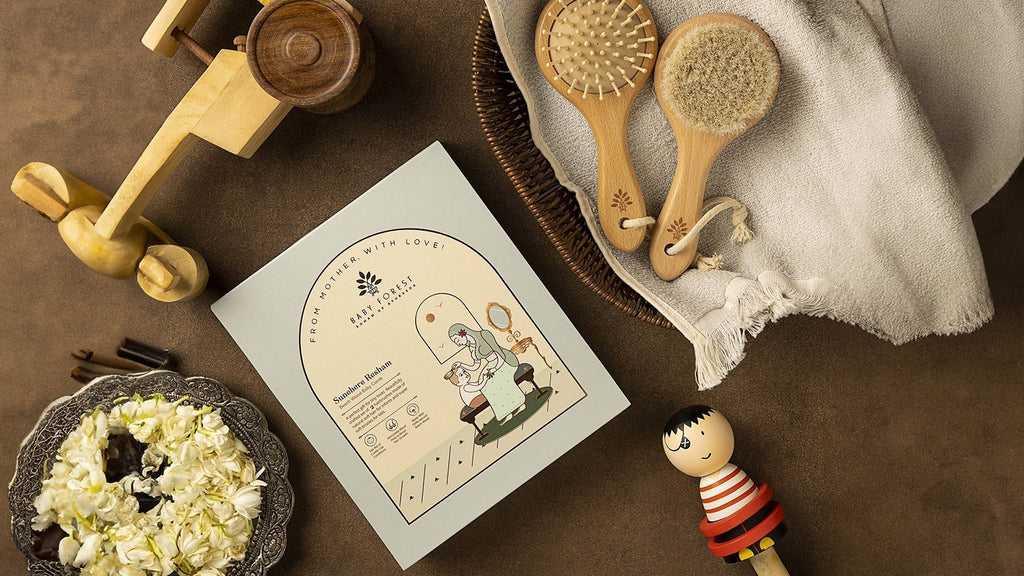
The Importance of Using a Gentle Comb for Your Baby's Hair
Infant hair care is more than a simple grooming routine; it's an essential part of their overall health and well-being. Babies' hair and scalp are very delicate, and they require gentle care to prevent discomfort or harm. This article will explain why using a gentle comb for your baby's hair is crucial, highlight the risks associated with regular combs, and outline the features and benefits of a gentle baby comb.
Understanding Baby's Hair and Scalp
Baby’s scalp is sensitive, and their hair is fine and fragile. Their skin and hair are still developing and can be easily irritated by rough handling or harsh materials. A baby's scalp can also be prone to conditions like cradle cap, which involves patchy, scaly skin. Hence, gentle care is essential to avoid aggravating these conditions or causing discomfort.
The Risks of Using Regular Combs
Regular combs, designed for adults or older children, are often too harsh for a baby's tender scalp. Their hard materials and sharp teeth can scratch or irritate the skin, leading to discomfort or even skin infections. Moreover, these combs can tug at fine baby hair, causing breakage or pain during grooming.
How to Choose the Right Baby Comb
When you look at buying a baby comb, you can consider the following factors:
-
Material:
Look for natural materials like wood and soft goat hair that are safe and gentle for your baby. -
Design:
Choose a comb with rounded teeth and a comfortable handle for easy and safe grooming. -
Size:
A compact size is preferable for the precise combing of fine baby hair and for convenient storage.
Features of Baby Forest’s Gentle Baby Comb
Our gentle baby comb is designed with the baby's delicate scalp and hair in mind.
-
Super Soft Goat Hair:
Ideal for infants and kids, these bristles are gentle enough to massage the scalp without causing irritation. -
100% Natural Beech Wood:
This baby comb is not only eco-friendly but also exceptionally durable and safe for the baby. -
Specially Designed Teeth:
The teeth of the baby comb are rounded and spaced to glide through fine hair without pulling or snagging.
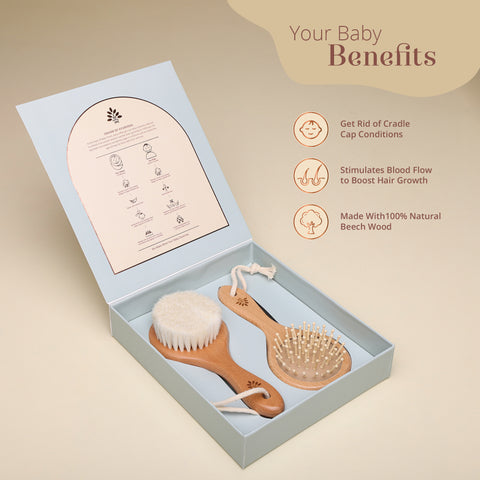
Benefits of Regularly Combing Your Baby's Hair with a Gentle Comb
Regularly combing your baby's hair with a gentle comb is more than just a routine grooming activity; it is an essential practice that offers numerous benefits for both the baby and the parent.
-
Promotes Healthy Hair Growth
Combing regularly with a soft comb aids in stimulating the scalp, which boosts blood flow to the hair roots. This stimulation promotes healthier and stronger hair growth by ensuring that the hair follicles receive ample nutrients and oxygen. Even spreading the scalp's natural oils along the hair shaft nourishes the hair, thus reducing its susceptibility to breaking.
-
Detects and Prevents Scalp Issues Early
Regular combing allows parents to closely inspect their baby's scalp regularly, making it easier to spot any potential issues such as dryness, cradle cap, or unusual spots early on. Early detection means that any conditions can be addressed promptly, preventing discomfort for the baby and potentially avoiding more serious complications.
-
Alleviates Cradle Cap
Cradle caps, characterized by scaly or crusty patches on the scalp, are common in babies. Regularly combing your baby's hair with a gentle comb can help loosen and remove these scales in a gentle manner, especially when combined with appropriate baby oil or shampoo. This keeps the baby's scalp clean and helps alleviate the symptoms of cradle cap.
Related Read - Dealing with Cradle Cap: Causes, Treatment Options, and Proactive Prevention
Combing Techniques and Tips
To make the most of your infant's hair care routine, consider these tips:
-
Gentle Approach:
Always comb gently, starting from the tips and working your way up to the roots to detangle hair without pulling. -
Regular Routine:
Make combing a part of your daily routine to keep your baby's hair neat and to monitor the health of their scalp. -
Cleanliness:
Keep the comb clean to prevent the buildup of oils or cradle cap flakes, ensuring hygiene.
Related Read - An Ideal Hair Care For Babies- What You Must Know?
ConclusionCaring for your baby's hair with a gentle hairbrush is an act of love and attention. It not only ensures their comfort but also promotes healthy hair growth and scalp health. Combing your baby's hair is a loving gesture that keeps them comfortable and supports their hair and scalp health. Choose the right newborn hairbrush and comb their hair gently, making it a soothing and bonding experience. Remember, the key is to be gentle and patient and to use the right tools to care for your baby's delicate hair and scalp.
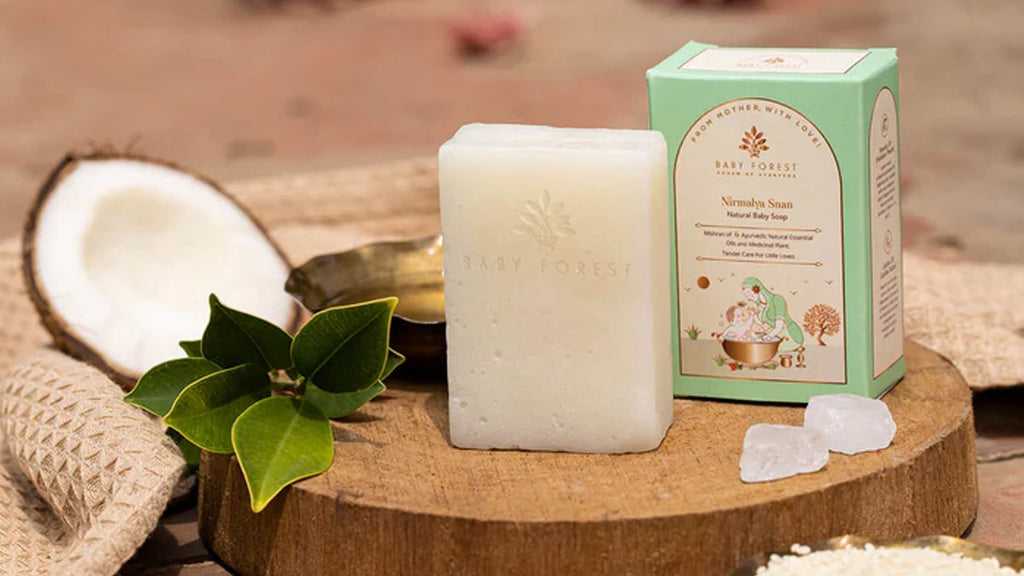
Natural Baby Soaps for Chemical-Free Bath Time
Because so many household goods include chemicals, it is essential that we put our children's health first when it comes to the purity of the products they use. Whether your kid is seven days, seven weeks, or seven months old, one thing remains constant: their sensitive and gentle skin. As a result, many bath and skin care products you use on yourself might cause rashes and irritation. Parents have become increasingly mindful of choosing baby products, which has led to a growing preference for natural baby products.
Bathing your baby is not just a task but a nurturing experience for their well-being. This blog will help you understand the benefits of choosing natural baby soaps and provide guidance on how to select the best soap for infants, guaranteeing a chemical-free bathing experience.
Why Choose Natural Baby Soaps?
Our skin is the biggest part of our body that shields our insides from the outside world. This is especially important for babies because their skin is significantly thinner than that of adults. This makes a baby's skin more delicate and also lets chemicals from normal soap get into the skin more easily. One study found that babies exposed to harsh soaps and shampoos are more likely to get skin problems like eczema and other skin irritations.
This is where natural baby soaps help with their organic ingredients, which makes it safer with no synthetic smells or harsh chemicals in them. These soaps only contain natural ingredients like coconut oil and shea butter. These natural ingredients are gentle and soft on a baby's skin.
How to Choose the Right Natural Baby Soap for Your Baby?
Choosing the right natural baby soap is crucial for your little one's delicate skin. With so many alternatives available, it might be difficult to choose the best one. However, focusing on specific qualities and ingredients can guide you in making a healthier choice for your baby. Here's how to ensure the soap you select is gentle, safe, and beneficial for your baby's bath time.
-
Paraben-Free
Parabens are preservatives used to prolong the shelf life of products, but they can disrupt hormone function, which is especially risky for babies. Opting for paraben-free baby soap ensures that your child is not exposed to these chemicals, making bath time safer.
-
Tear-Free
A tear-free formula is essential for baby soaps to prevent eye irritation during bath time. This means the soap is gentle enough that it won't sting your baby's sensitive eyes, making for a more pleasant bathing experience for both of you.
-
Natural Ingredients
Natural ingredients are the cornerstone of a good baby soap. Look at infant soaps with ingredients such as Jojoba Oil, Castor Oil, Coconut Oil, Sesame Oil, Rosehip Oil, and Aloe Vera. Chemical additives can be harsh on a baby's skin, leading to dryness and irritation. Natural soaps, on the other hand, use ingredients that are gentle and nourishing.
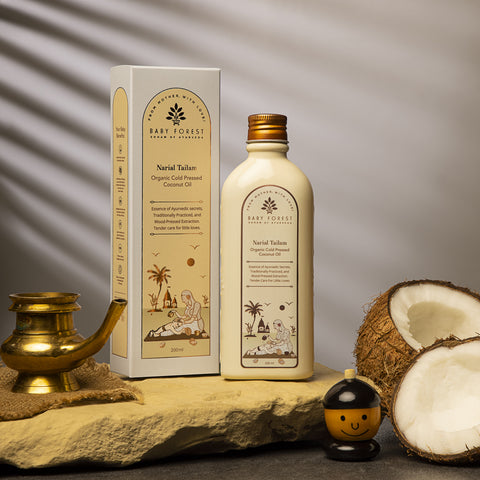
-
Vegan
Vegan baby soaps are made without any animal products or by-products, aligning with eco-friendly and cruelty-free practices. These soaps are also more likely to contain plant-based ingredients that are gentle and beneficial for the skin.
How to Use Baby Forest's Nirmalya Snan Natural Baby Soap?
To use the soap bar, simply wet your baby's skin with warm water, then gently rub the soap bar over their skin to create a soft lather. Massage the lather gently across their body with your hands or a soft washcloth. After ensuring their skin is thoroughly cleansed, rinse off the lather with plenty of water, making sure no soap residue remains.
When choosing baby care products, it's important to consider your child's well-being and the environment. Natural baby soaps are a great option, as they are gentle on your baby's skin and free from harsh chemicals. This helps create a safe and enjoyable bathtime experience for your little one. By choosing natural products, you're also contributing to a more sustainable world, reducing your exposure to harmful chemicals. This is a worthwhile investment in your child's health and the future of our planet.

Why Prospective Parent Should Know About Beej Sanskar
In the journey towards parenthood, the ancient wisdom of Beej Sanskar offers a unique and holistic approach to conceiving a healthy, intelligent, and spiritually grounded child. This traditional practice, deeply rooted in Ayurveda, emphasizes the purification of the sperm and ovum—collectively known as the "beej" or seeds—before conception.
It's a process that aims to enhance not only the physical health of the future child but also its intellectual and spiritual vitality. Here's everything a parent to be should know about Beej Sanskar and why it's considered an essential step for those looking to expand their family.
What is Beej Sanskar?
Beej Sanskar is based on the principle that the health and qualities of a soon to be parent at the time of conception significantly influence the health, intellect, and spiritual disposition of their child. It involves a series of Ayurvedic detoxification and purification procedures known as Panchakarma, tailored specifically to cleanse the reproductive tissues. This is believed to result in the creation of a pure, healthy environment conducive to conceiving a child free from physical and genetic abnormalities.
Key Components of Beej Sanskar
-
Detoxification with Panchakarma
Panchakarma is a set of five procedures designed to cleanse the body of toxins. In the context of Beej Sanskar, it helps detoxify the ovum and sperm, ensuring they are in their purest and healthiest form. -
Diet and Lifestyle Adjustments
Prospective parents are advised to follow a special diet and make lifestyle changes that promote reproductive health. This includes eating nourishing, sattvic foods and engaging in activities that bring balance and well-being. -
Natural Treatments
Ayurvedic treatments like Uttar Basti (a medicated oil or decoction enema for reproductive organs), Pichu Dharan (a vaginal tampon soaked in medicated oil for healing), and Dhawan (medicinal smoke) are used to enhance the internal environment of the mother's womb, making it more suitable for conception.
Why Opt for Beej Sanskar?
Beej Sanskar is not only for those who dream of parenthood but also addresses various reproductive health issues, such as:
- Infertility
- Polycystic Ovary Syndrome (PCOD)
- Recurrent miscarriages
- Congenital anomalies in the child
By addressing these concerns at their root, Beej Sanskar provides a comprehensive solution for couples looking to overcome obstacles to parenthood.
The Benefits of Beej Sanskar
For the Child
The most significant benefit of Beej Sanskar is the birth of a healthy and intellectually gifted child. The practices associated with this sanskar aim to imbue the child with positive attributes even before conception, setting a strong foundation for their future development.
For the Prospective Parent
Beyond the benefits for the child, Beej Sanskar encourages to be parents to adopt healthier lifestyles and achieve a state of physical and emotional purity. It fosters a deeper connection between the expecting parents and their child, rooted in the shared experience of preparing for conception in a mindful and spiritual manner.
Preparing for Beej Sanskar
Embarking on the Beej Sanskar journey requires commitment and preparation. Prospective parents should seek guidance from experienced Ayurvedic practitioners who can tailor the Panchakarma and other treatments to their specific needs. Additionally, embracing a holistic lifestyle that incorporates Ayurvedic dietary principles, regular exercise, and stress-reduction techniques like meditation can enhance the effectiveness of Beej Sanskar.
Beej Sanskar represents a profound commitment to bringing a new life into the world under the best possible conditions. It is a testament to the power of traditional wisdom in addressing contemporary health challenges and fostering a holistic approach to conception and childbirth. By making sure the seeds (sperm and ovum) are pure and healthy, the prospective parents help create children who are strong in body, smart in mind, and rich in spirit.
In Ayurveda, it's important to have your doshas (body energies: Vata, Pitta, Kapha) in balance. Seeing an Ayurvedic practitioner can help you understand your dosha balance and what you need to do to maintain it. Practices like yoga and meditation can also help keep your mind calm and reduce stress. You can engage in consistent physical activity, ensuring adequate rest, and steering clear of detrimental habits such as smoking and drinking can significantly enhance your prospects of experiencing a healthy pregnancy.
Related Read - Unlocking the Wonders of Garbh Sanskar
Whether you're a new parent looking for inspiration for the perfect baby shower gift ideas or simply looking for any essential baby care product, like the best baby lotion, our resources are designed to guide you every step of the way.
You can also read more about the traditional and modern significance of using a mustard seed pillow for your little one and explore its various benefits. Or, if you're interested in understanding the richness of Indian ceremonies for your child, our detailed guides on the Annaprashan ceremony and Mundan ceremony will offer insights and practical tips to celebrate these milestones for your little one.
You can read more blogs to ensure that your parenting path is well-informed, joyful, and rich in tradition and care.
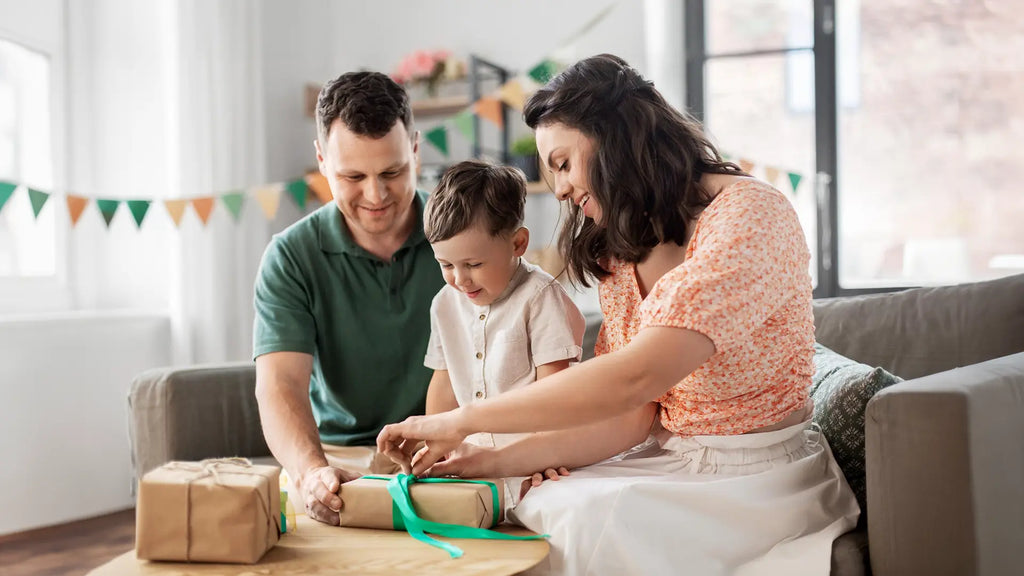
5 Mindful Gift Ideas for New Parents
In the joyous journey of welcoming a new life into the world, the act of gifting holds a special place in our hearts. Mindful gifting, especially for new parents, transcends the mere exchange of presents; it is a heartfelt gesture that nurtures the bond between the giver and the recipient. It's about choosing gifts for babies that not only delight but also offer practical utility and convey thoughtfulness.
In the realm of new parenthood, where sleepless nights meet the endless wonder of baby care, selecting the perfect gift for newborn becomes even more poignant. Here are five mindful gifts that stand out not just for their novelty but for their ability to blend functionality with care, making them invaluable to new parents.
-
Wooden Gifting Box
Imagine a treasure trove that caters to the tender needs of a newborn; all encased in a beautifully crafted wooden box. This newborn gift hamper isn't just a container; it's a thoughtful compilation of essentials for the little one, including baby body wash, baby kajal, mustard pillow, baby shampoo, massage oil, and more. Each item is chosen with the baby's delicate skin and care requirements in mind, ensuring that the new parents have everything they need for their bundle of joy's initial days. The wooden gifting box is not just a gift; it's a gesture of comprehensive care, embodying the essence of mindful gifting by providing practical, usable items that ease the parents' new journey. You can also personalise and get a note written for your loved ones.
Related Read - 5 Best Baby Shower Gift Ideas for New Moms

-
Organic Holi Hamper
As the vibrant season of Holi approaches, parents eagerly seek ways to introduce their little ones to this colourful festivity, mindful of their delicate needs. The Organic Holi Hamper is a perfect companion for such vibrant celebrations, with organic gulal that promises safe, chemical-free play, along with a gentle baby face wash and cream, ensuring the little one's skin is cared for, both during and after the joyous splashing of colours.

-
Baby Swaddle Set
A good night's sleep is precious for both the baby and the parents. The Baby Swaddle Set, made from bamboo muslin, is a gift of comfort and serenity. Bamboo muslin is known for its softness, breathability, and ability to regulate temperature, making it the perfect material to swaddle a newborn for a peaceful sleep. This set not only helps the baby sleep better but also eases the parents' minds, knowing their little one is wrapped in comfort. It's a thoughtful gift idea for newborns that directly impacts the baby's and the parent's well-being, making it a quintessential example of mindful gifting.
Related Read - The Essential Guide to Perfect Swaddling: Techniques and Tips for New Parents
-
Baby Bamboo Feeding Bowl
Mealtime can be a challenge for new parents, but the Baby Bamboo Feeding Bowl turns it into an enjoyable learning experience. With its silicon suction base, the bowl firmly grips onto flat surfaces, significantly reducing spillage. This feature is particularly thoughtful, as it helps the baby learn to feed themselves with less mess, making the weaning process smoother for both the baby and the parents. The bamboo bowl is not only easy to clean but also durable, ensuring it remains a staple in the baby's mealtime adventures. It's a functional, practical gift that acknowledges and addresses the realities of parenting, making it a mindful choice.
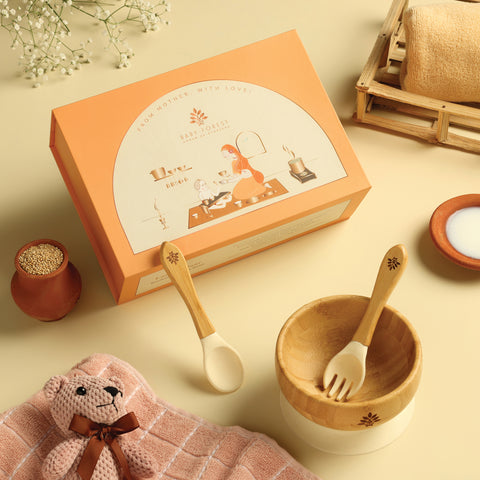
-
Kaumarbhritya Baby Gifting Book
Blending the ancient wisdom of baby care with contemporary design, the Kaumarbhritya Baby Gifting Book is a treasure of knowledge and care essentials. This handcrafted book set, beautifully packed with body lotion, baby shampoo, baby body wash, baby face cream, and more, offers a holistic approach to baby care. It's a gift that educates and pampers, providing new parents with a guide to nurturing their baby with the wisdom of the ages, making it an invaluable addition to their baby care collection.

When we pick gifts that can be used every day, it shows we really thought about what the new mom and dad need. These kinds of gifts are not just nice to look at; they help out in real ways. Whether it's making baby bath time easier or keeping the little one snug and warm, each gift has a special role in the family's daily life. This means a lot because it's like saying, "I understand what you're going through, and I want to help." Giving something useful is a way to show love and support, making the new parents' journey a bit smoother and more enjoyable.
These gifts encapsulate this philosophy beautifully, making them the perfect choice for anyone looking to make a difference in the lives of new parents and their precious newborns.
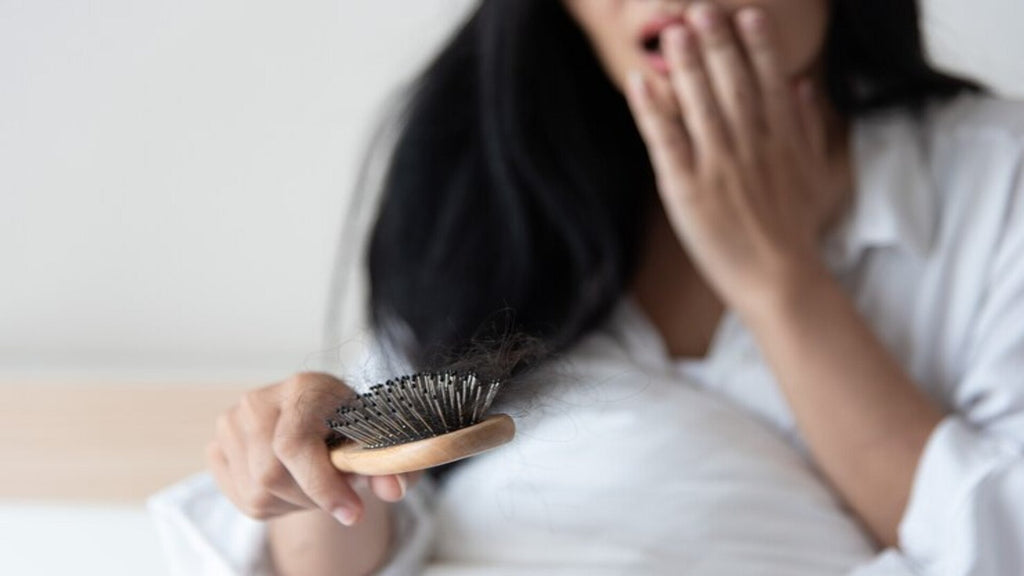
Pregnancy Hair Loss: What Moms Need to Know
Pregnancy brings a whirlwind of emotions and transformations, with some shifts being unexpectedly striking. One such change that doesn't get as much attention is hair loss during and after pregnancy. If you're experiencing this, know that you're not alone. This article is here to guide you through understanding pregnancy-related hair loss, why it happens, and how to manage it.
Understanding Hair Loss in Pregnancy
Most people picture pregnancy as a time when women have thick, luscious hair. And it's true, during pregnancy, many women find their hair feels fuller. But what happens after the baby arrives can be quite the opposite. Some new moms start to notice their hair falling out in clumps. This can be alarming, but it's a common experience.
Why Does Hair Loss Happen During and After Pregnancy?
The main culprit behind hair loss before, during, or after pregnancy is hormones. Throughout pregnancy, your body undergoes a significant increase in estrogen and progesterone levels. These hormones can cause your hair to remain in a growth phase, leading to less shedding and thicker hair.
However, after childbirth, your hormone levels drop dramatically. This sudden change can shock your hair follicles, pushing more hair into the resting phase. Several months following the birth of your baby, you may observe an unusual amount of hair shedding. This phenomenon is referred to as postpartum hair loss, also known as telogen effluvium.
What Can You Do About Hair Loss During Pregnancy?
First and foremost, it's important to understand that this phase is temporary. Most women see their hair return to its pre-pregnancy condition within 6 to 12 months after childbirth. However, there are steps you can take to manage hair loss and care for your hair during this time.
-
Maintaining a Healthy and Nutritional Diet
For your hair to grow robust and healthy, it requires essential nutrients. Make sure your diet includes a whole lot of vitamins and minerals conducive to hair growth, like iron, zinc, vitamin D, and proteins. Consuming a well-rounded diet benefits not just hair loss management but also contributes significantly to your comprehensive recovery post-pregnancy.
Related Read - What to Eat When Pregnant: Your Ultimate Guide to a Healthy Pregnancy Diet -
Be Gentle with Your Hair
Try to minimize stress on your hair. Avoid hairstyles that pull tightly on your scalp, like ponytails or braids. When brushing your hair, use a wide-toothed comb to gently detangle your hair, reducing breakage. -
Choose the Right Hair Care Products
You can look for shampoos and conditioners that are designed for thinning hair as they can help make your hair appear fuller. Also, avoid heavy styling products, as they can weigh down your hair and make hair loss more noticeable.
-
Consider Supplements
After consulting with your healthcare provider, you might consider taking supplements to support hair growth. Vitamins like biotin and vitamin E have been known to help, but it's important to get professional advice before starting any new supplement, especially if you are breastfeeding.
-
Manage Stress
Caring for a newborn is often filled with stress, and this can further intensify hair loss. It's important to discover methods to unwind and minimize stress levels. Practices such as meditation, light physical activity, or reaching out for support from friends and family can have a substantial impact. -
Consult with a Professional
If hair loss is causing you worry, it's important to consult with a healthcare provider or dermatologist. They can provide advice and, if needed, suggest treatments or diagnostic tests to verify that no severe underlying condition is causing your hair loss.
When to See a Doctor?
Although postpartum hair loss is typical, unusually heavy shedding may indicate a deeper health concern, like thyroid disorders or anaemia. If you notice your hair loss is severe or accompanied by other symptoms, it's important to seek medical advice.
Pregnancy-related hair loss can be a distressing experience, but it's a temporary and normal part of the postpartum period for many women. By understanding why it happens and taking steps to care for your hair and health, you can navigate this change more comfortably. Remember, this phase will pass, and your hair will gradually return to its normal cycle. In the meantime, focus on your well-being and enjoying time with your new baby.

Benefits of Baby Rose Water for Your Little One
Caring for your baby's skin is as essential as nurturing their health. In a world teeming with baby skin care products, finding the gentlest and most natural option for your little one can be a challenge. Among the myriad choices, baby rose water stands out as a remarkable solution that not only pampers but also benefits your baby's delicate skin.
Crafted from the essence of native rose petals, it brings nature's best to your baby's skincare routine. Here are a few
Benefits of incorporating baby rose water into your daily routine:
-
Soothing Calmness
The core ingredient, Rosa Damascena flower water, is renowned for its calming properties. Native rose petals are carefully selected and distilled to create rose water and it offers a soothing touch to your baby's skin. The natural fragrance of roses is not just a scent but a sensory experience that calms the mind and body. It's like wrapping your baby in a soft, fragrant hug that soothes them into peacefulness. The delicate aroma of roses also ensures your baby enjoys a luxurious, calming bath time, making it a serene ritual.
-
Hydration and Nourishment
Baby rose water is a fantastic hydrator. Due to its vital formulation, enriched with Vitamin E, it aids in preserving the skin's moisture barrier, which helps in avoiding dryness and ensures the skin remains smooth and pliable. This works as a natural moisturizer that absorbs easily without leaving any greasy residue, ensuring your baby's skin remains hydrated and nourished. -
Natural and Safe Ingredients
When choosing rose water for your baby, it's crucial to opt for a product with natural and safe ingredients. A formula comprising Rosa Damascena Flower Water and Vitamin E, without any added chemicals, is ideal. This ensures that the product is gentle on your baby's skin and free from any harmful substances. By selecting a natural, cruelty-free, and derma safe rose water, you provide your baby with the safest and most loving care.
-
Versatility
Its natural soothing properties make it an excellent choice for various situations – from diaper changes to after bath time, ensuring your baby's skin remains clean, calm, and refreshed. On hot and humid days, a quick spritz of rose water can provide an instant refreshment for your baby, helping to cool and soothe their delicate skin. The gentle fragrance of rose water also adds a mild, pleasant scent that can comfort and relax your baby, making it a perfect, all-natural way to enhance their overall well-being and comfort throughout the day.
Pro Tip for Using the Gulaab Oose - Baby Rose Water Mist:
To enhance the nourishment and softness, combine a few drops of the rose water mist with Loi Ubtan Powder and gently massage it into your baby's skin. This blends not only hydrates but also leaves the skin incredibly soft, supple, and with a healthy glow. It's a simple yet effective way to enhance the natural benefits of rose water, providing your baby with the ultimate skincare treatment.
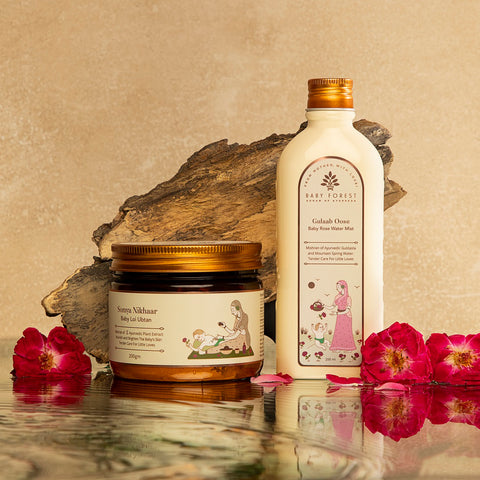
Related Read - Baby Loi Ubtan: Traditional & Modern Care for Stylish Moms
Selecting the appropriate skincare products for your baby is crucial. By choosing a product that is natural, cruelty-free, and free from harsh chemicals, you're guaranteeing that your baby benefits from the finest offerings of nature. Incorporate baby rose water into your baby's skincare routine for a touch of nature's gentleness and purity, embracing its benefits for a happy, healthy baby.
Whether you're a new parent looking for inspiration for the perfect baby shower gift ideas or simply looking for any essential baby care product, like the best baby lotion, our resources are designed to guide you every step of the way.
You can also read more about the traditional and modern significance of using a mustard seed pillow for your little one and explore its various benefits. Or, if you're interested in understanding the richness of Indian ceremonies for your child, our detailed guides on the Annaprashan ceremony and Mundan ceremony will offer insights and practical tips to celebrate these milestones for your little one.
You can read more blogs to ensure that your parenting path is well-informed, joyful, and rich in tradition and care.
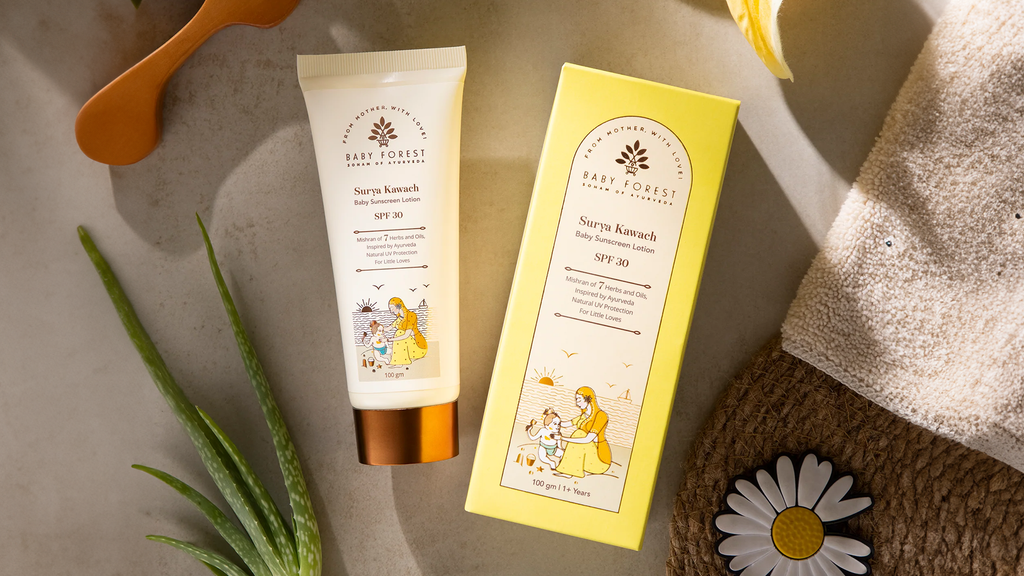
The Importance of Sun Protection: Why Baby Sunscreen is a...
In the warm embrace of sunlight, babies experience not just the joy of being outdoors but also the potential risk of sun damage to their delicate skin. Understanding the importance of sun protection for infants is crucial for ensuring their well-being. This article will delve into the reasons why baby sunscreen is a must, covering various aspects to enhance your awareness and guide you in safeguarding your little ones.
Baby Skin Vulnerability to Sun Damage:
To comprehend the significance of sun protection, it's essential to recognize the vulnerability of baby skin. Infants have thinner, more delicate skin that is highly susceptible to harmful UV rays. Unlike adults, their skin has not fully developed the natural defenses needed to shield them from the sun's impact.
Harmful Effects of Sun Exposure on Babies:
Sun exposure can have severe consequences on a baby's skin. From sunburns to long-term damage, the risks are substantial. UV rays have the capability to infiltrate the skin, potentially causing concerns like dehydration, heatstroke, and an elevated susceptibility to skin cancer in the future. It's imperative to address these potential hazards through effective sun protection measures.
Why Regular Sunscreen Isn't Suitable?
Not all sunscreens are made equal, and sunscreens meant for adults may not be suitable for baby skin. Chemical ingredients found in some sunscreens can be harsh, causing irritation and allergic reactions. Understanding the characteristics of baby sunscreen becomes crucial to ensure optimal protection without compromising safety.
Characteristics of Baby Sunscreen:
Tailored to the distinctive requirements of infant skin, baby sunscreens stand out for their specialized formulation. These sunscreens are often infused with potent natural ingredients such as Seabuckthorn Oil, Carrot Oil, Red Raspberry Seed, and other beneficial herbs and oils. This unique blend not only delivers effective natural sun protection but also contributes to the overall well-being of the baby's delicate skin.
In addition to their natural composition, these sunscreens prioritize gentleness, employ a nongreasy formula, and are suitable for daily use that shields against UV rays without causing irritation. The inclusion of Seabuckthorn Oil, Carrot Oil, and Red Raspberry Seed adds an extra layer of nourishment, ensuring that the baby's skin remains soft and hydrated after application.
How to Apply Baby Sunscreen Lotion?
To apply the Baby Forest Surya Kawach Sunscreen Lotion effectively, start by dispensing a small amount onto your palms. Gently rub the lotion in your hands to ensure even distribution. When applying to your baby's face and body, pay special attention to areas such as the cheeks, neck, and ears. To achieve the best outcome, it is advisable to apply the Baby Forest Surya Kawach Sunscreen Lotion to moistened skin. This helps in seamless absorption and enhances the effectiveness of the sunscreen.

Tips for Sun Protection on Adventures:
Adventurous outings with your little one require extra precautions and these additional measures contribute to a safer and more enjoyable outdoor experience.
-
Choose the Right Time for Outings:
When planning outdoor activities with your baby, try to schedule them during the early morning or late afternoon when the sun's intensity is lower. This reduces the risk of exposure to harsh midday sunlight. -
Opt for Shade Solutions:
When outdoors, look for shaded areas or create your own shade with a stroller canopy, a baby sun tent, or a portable umbrella. This ensures a cool and protected environment for your baby to enjoy.
-
Stay Hydrated:
Hydration is crucial, especially during sunny days. Keep your baby well-hydrated by offering fluids regularly. If your baby is still breastfeeding, ensure they are nursing adequately, and if they've started solids, offer water in a sippy cup. -
Cooling Accessories:
Consider using cooling accessories like baby-friendly cooling pads or towels to keep your little one comfortable in the heat. These accessories can be especially useful during warmer weather. -
Be Mindful of Hot Surfaces:
Be cautious of hot surfaces, such as playground equipment, car seats, or sand, that can become uncomfortably warm in the sun. Check surface temperatures before placing your baby down to avoid burns or discomfort.
-
Monitor Sunscreen Expiry Dates:
Check the expiration dates on your baby's sunscreen lotion regularly. Expired sunscreen may lose its effectiveness, compromising the level of protection it offers. Replace it promptly to ensure continuous safety.
Conclusion
Understanding the importance of sun protection for babies goes beyond the application of sunscreen. It involves recognizing the vulnerability of baby skin, comprehending the harmful effects of sun exposure, and adopting a holistic approach to safeguarding against UV rays. By prioritizing baby sunscreen with suitable characteristics and implementing additional protective measures, parents can ensure their little ones bask in the warmth of the sun without compromising their health. Embrace the responsibility of nurturing your baby's skin, and let each outdoor adventure be a safe and joyous experience.

How to clean/wash baby feeding bottle?
For new parents and caregivers, cleaning and washing baby feeding bottles is an essential step in maintaining proper hygiene for the baby. It helps in preventing the growth of bacteria and other contaminants, which ensures the safety of your baby. Cleaning baby feeding bottles is a crucial task that needs to be performed regularly since, with time, baby bottles can get dirty and contaminated. Thus, it is important to follow proper cleaning procedures. Whether you're using them for formula or expressed breast milk, keeping these bottles clean is crucial for your baby's health. However, do not worry; this guide is designed to make the process as simple and stress-free as possible.
Choosing the Right Feeding Bottle
Before we dive into cleaning, let's talk about selecting the right feeding bottle for your baby. Not all bottles are created equal and finding the perfect one can save you a lot of time and hassle down the line.
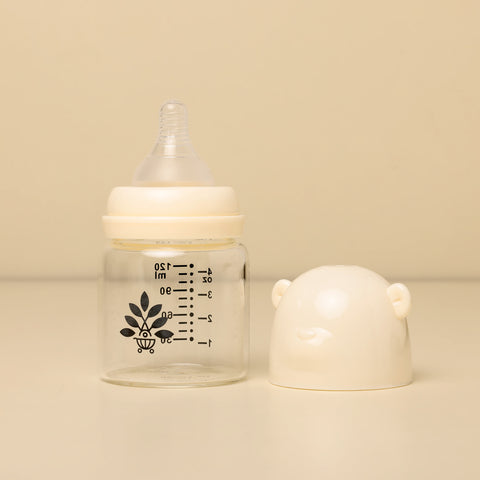
Look for Easy-to-Clean Designs
An ultra-wide neck design is something to consider when choosing a bottle. This feature makes it easier to clean the bottle by hand, ensuring that you can reach all parts of the bottle without the need for special brushes or tools. Bottles with fewer parts are also easier to clean and reassemble.
Consider Dishwasher Safety
If you have a dishwasher, you have to ensure that your chosen bottle should be dishwasher-safe. This can significantly streamline the cleaning process. However, it's still important to occasionally deep-clean bottles by hand to ensure that no residue or milk build-up is left behind.
Mimic Breastfeeding
When selecting the perfect baby feeding bottle for your little one, especially for breastfeeding infants, finding a bottle that closely mimics breastfeeding can make a significant difference. Opt for bottles whose nipple design is specifically crafted to replicate the breastfeeding experience. This design promotes a seamless transition from breast to bottle, making it easier for your baby to adapt without confusion or refusal.
Cleaning Baby Feeding Bottles: Step-by-Step
Now, let's break down the process and understand how to clean your baby's feeding bottles. It's not as daunting as it might seem!
-
Preparation
- Rinse Immediately: After feeding, rinse the bottle with cold water to remove any leftover milk before it dries.
- Disassemble the Bottle: Take apart all the pieces of the bottle - the bottle itself, nipple, cap, and any valves or rings.
-
Hand Washing
- Soak in Hot Soapy Water: Use a basin or a clean sink filled with hot water and add some mild dish cleaner. Soak the bottle parts for a few minutes.
- Scrub Thoroughly: Use a clean bottle brush to scrub inside the bottle and nipple. The ultra-wide neck design of some bottles makes this step easier. Be sure to clean every nook and cranny, paying special attention to the base of the nipple.
- Rinse Well: Rinse each part under clean running water to ensure all soap residue is removed.
-
Drying
- Air Dry: Place all washed and rinsed bottle parts on a clean drying rack or towel in an area free from dust and touching surfaces.
Sanitising Baby Feeding Bottles
While washing with hot, soapy water is sufficient for daily cleaning, sterilising your baby's bottles can offer extra protection, especially for newborns or babies with weaker immune systems.
-
Boiling
Place bottle parts in a large pot, cover them with water, and boil for 5 minutes. -
Steam Sanitising
Use a microwave or electric steam sanitiser according to the manufacturer's instructions.
Once the bottles are dry, reassemble them to prevent any contamination from dust or pests. Store the clean bottles in a clean, dry cabinet until they are ready to be used again.
Cleaning your baby's feeding bottles might seem like a daunting task, but with the right tools and a bit of knowledge, it can become a quick and simple part of your routine. Remember, a well-chosen bottle can make this task easier, so consider options with an ultra-wide neck design for hassle-free cleaning. With these tips, you'll ensure that your baby's feeding bottles are always clean, safe, and ready for use.
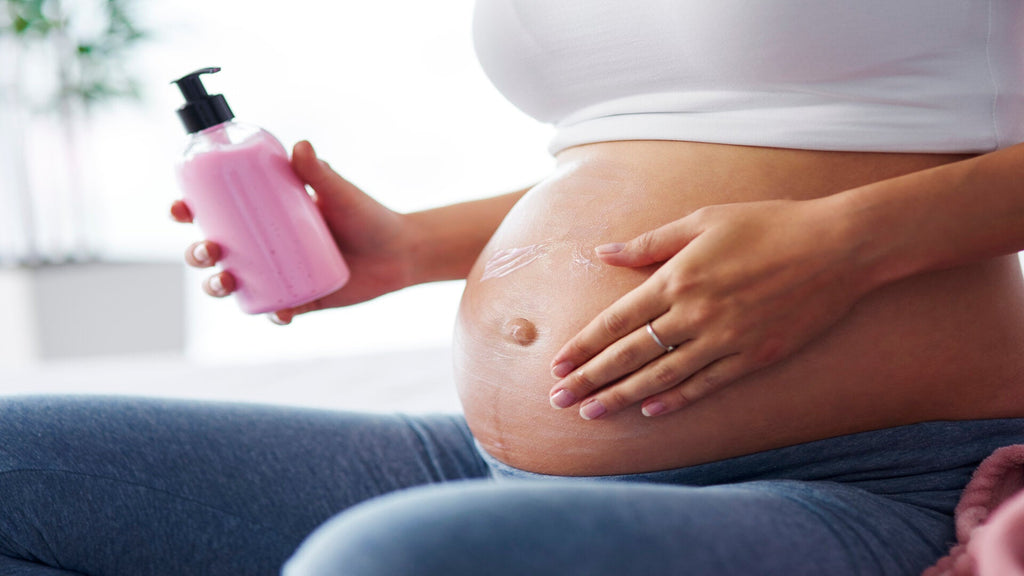
Natural Remedies for Preventing and Treating Pregnancy St...
Bringing a new life into the world is a lovely experience, but it frequently involves bodily changes, one of which is pregnancy stretch marks. These marks are a natural part of the body's adaptation to the miraculous process of pregnancy. In this complete guide, we will look at natural methods for preventing and treating pregnant stretch marks, as well as provide new mothers with comfort and information.
Understanding Pregnancy Stretch Marks:
Pregnancy stretch marks, scientifically known as striae gravidarum, are caused by the stretching of the skin during rapid weight gain or growth, which is common during pregnancy. The skin's elasticity is put to the test as the belly, breasts, and hips expand to accommodate the growing baby. While these marks are a testament to the incredible journey of motherhood, many women seek ways to minimize or prevent them.
How to Prevent Stretch Marks During Pregnancy?
Hydration is Key:
Staying hydrated is vital for retaining skin suppleness. Drinking an ample amount of water helps keep the skin supple and aids in preventing stretch marks. Aim for at least eight glasses of water a day.
Balanced Nutrition:
A diet rich in vitamins and minerals contributes to skin health. Incorporate foods high in vitamins A and C, which promote collagen production and skin regeneration. Foods like carrots, sweet potatoes, and citrus fruits can be beneficial.
Related Read - What to Eat When Pregnant: Your Ultimate Guide to a Healthy Pregnancy Diet
Gentle Exercise:
Engage in gentle, pregnancy-safe exercises to promote blood circulation and prevent excessive weight gain. Activities like prenatal yoga and swimming can be beneficial for both physical and mental well-being.
Natural Oils:
Applying natural oils such as almond oil, coconut oil, or olive oil to the skin helps keep it moisturized and improves elasticity. Massage these oils onto areas prone to stretch marks regularly.
Massage and Self-Care
Regular massage with natural oils not only nourishes the skin but also promotes relaxation and self-care. Taking time for yourself during pregnancy can be a valuable aspect of preventing stretch marks.
How to Treat Stretch Marks After Pregnancy?
Bio-Oil Therapy:
Bio-oil, enriched with botanical extracts, is a popular choice for treating stretch marks. Apply it consistently to affected areas, massaging gently for optimal absorption.
Aloe Vera Gel:
Aloe vera, recognized for its calming properties, has the potential to reduce the visibility of stretch marks. Apply pure aloe vera gel to the affected areas and leave it on for 15-20 minutes before rinsing.
Cocoa Butter:
The hydrating qualities of cocoa butter are well-known. Regularly applying cocoa butter to stretch marks hydrates the skin, improves suppleness, and reduces the visibility of the marks.
Experiencing stretch marks during pregnancy is a normal aspect of the incredible journey into motherhood. Embracing these natural changes and actively nurturing your skin can have a meaningful impact. Integrating these simple remedies into your daily routine not only promotes skin well-being but also uplifts your confidence, allowing you to fully immerse yourself in the joyful moments of being a new mom. Remember, every stretch mark tells a unique story of the miraculous journey you've undertaken, and they are a testament to the strength and resilience of the incredible female body.

5 Best Baby Shower Gift Ideas for New Moms
Finding the ideal baby shower present may be a wonderful yet difficult task. As the arrival of a new life brings joy and excitement, it also ushers in a whirlwind of needs and necessities for the newborn. If you're on the lookout for baby shower gift ideas that are unique, thoughtful, and genuinely useful for both the baby and the new mom, you've come to the right place. This article will walk you through the process of choosing the perfect baby shower gift, with a focus on products that are both charming and useful in caring for a newborn. Let's explore five heartwarming and beneficial gift ideas that will make any new mom feel loved and supported.
-
Sneh Sandook - Wooden Gifting Box
The journey of motherhood is filled with firsts—the first smile, the first step, and, of course, the first gifts. The Sneh Sandook, a wooden gifting box from Baby Forest inspired by Ayurveda, is an exquisite choice for a mindful gift that marks these firsts with a blend of tradition and care. This handcrafted wooden trunk is not just a gift; it's a treasure trove that contains a mindfully created baby wellness collection with bath ritual, and fun baby toys. It represents the first step towards embracing a traditional upbringing infused with the wisdom of Ayurveda.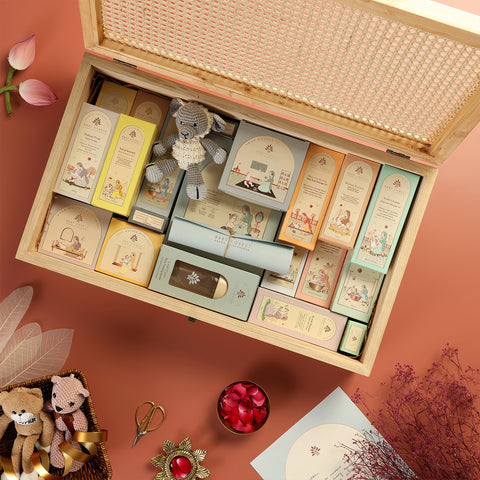
What sets the Sneh Sandook apart is its ability to be personalized with a handwritten note, making it a deeply meaningful gift for a baby shower for a mom. This personalised touch ensures that your gift carries a heartfelt message, making it one of the most memorable and useful gifts for newborn babies.
Related Read -How to Pick Safe Essential Baby Care Products
10 Essential Ayurvedic Products For Babies
-
Komal Aavran Set of 3 Baby Swaddles
Swaddling is an age-old ritual that makes babies feel safe and comfortable, similar to the snugness they felt in the womb. The Komal Aavran Swaddle Set is designed with this nurturing principle in mind. Made to be lightweight and breathable, these swaddles ensure your baby sleeps soundly and comfortably. The generous size of the swaddles makes them perfect for wrapping the baby snugly.

Included in this set is a complimentary Lady Elph soft toy and a handcrafted Sandook, adding a touch of whimsy and elegance. The Sandook, a piece of handmade art, serves as a charming addition to the nursery. This set stands out as a functional baby shower gift, combining functionality with aesthetic appeal, making it one of the best baby shower gifts for new moms seeking comfort and quality for their newborns.
Related Read - The Essential Guide to Perfect Swaddling: Techniques and Tips for New Parents -
Maasoom Petika
The Maasoom Petika is a wonderfully designed package that includes a variety of goods for the baby's massage, hair, and skincare requirements. This box is an ideal gift for various occasions, including baby showers, birthdays, and the first meeting with the baby. Its content is mindfully selected to ensure that each item serves a purpose in the baby's daily care routine, emphasizing the importance of promoting health and wellness from an early age.

Gifting the Maasoom Petika is a way of showing the new parents that you care about the comfort and health of their newborn. Its practicality and the sheer variety of care products that it consists of make it a standout choice for anyone searching for baby shower gifts that are both useful and thoughtful. -
Baby Bathing Products
In the realm of baby shower gifts, organic and natural baby bathing products are a utilisable and practical choice. These premium products, which include kids' face wash, baby face cream, body massage oil, cold-pressed coconut oil, baby shampoo, talc-free baby powder, and more are designed to be derma-safe, cruelty-free, and vegan. They offer the gentle care and protection that a newborn's sensitive skin requires.
Gifting a variety of these high-quality baby bathing supplies not only demonstrates your concern for the baby's health and well-being but also assists parents in providing a safe and caring atmosphere. These items are essential in any newborn's daily routine, making them excellent baby shower gifts for conscientious parents who value quality and safety in their baby care products.
Related Read - The Ultimate Baby Bathing Checklist for Your Baby's First Bath at Home -
Mustard Pillow
The Somya Aakar infant pillow, which is loaded with the natural goodness of lavender and mustard seeds, is a thoughtful and one-of-a-kind newborn gift. Designed to support the baby's neck posture and prevent the development of a flat head, this organic cotton pillow is an essential item for infants. It not only ensures spine alignment but also helps ease the pressure on the baby's neck, promoting a comfortable and restful sleep.
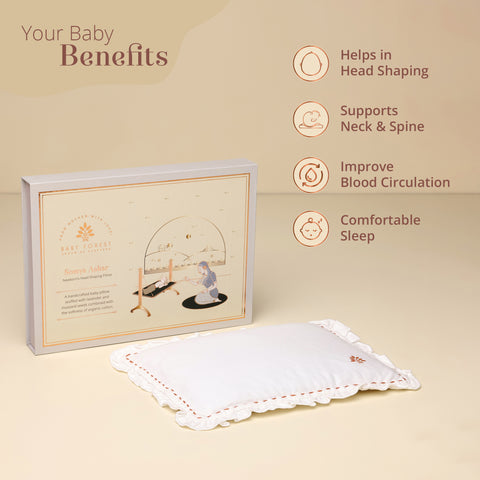
The Somya Aakar pillow, suitable for babies aged 0 to 6 months, is an excellent present that combines tradition and practicality. Its inclusion of lavender provides a calming effect, enhancing the baby's sleep quality. This makes it a highly recommended gift for baby showers, especially for moms who appreciate organic and natural care products for their newborns.
Choosing the ideal baby shower present is an opportunity to express love and support for the new mother and her baby. The gifts discussed above are not just apt; they are practical and infused with the care and consideration every newborn deserves.
Related Read - Mustard Seeds Pillow Benefits: Ideal for Your Newborn's Comfort and Health
When choosing a gift for a baby shower, consider the long-term benefits and the immediate joy it will bring to both the baby and the parents. These five gift ideas combine traditional wisdom with modern care, making them some of the greatest baby shower gifts you can give. Remember, the best gifts are those that come from the heart, reflecting your love and wishes for the newborn's happy and healthy future.

The Benefits of Using Water Wipes for Your Baby's Delicat...
In the life of a new parent, every choice made for their little one holds immense significance, especially when it comes to their comfort and health. One such pivotal decision revolves around selecting the right kind of baby wipes for the baby's delicate skin. There are numerous baby products available online, so it becomes crucial to understand why water wipes stand out as the optimal choice for your infant's hygiene and well-being.
Understanding the Delicate Nature of Your Baby's Skin
The skin of a baby is more sensitive when compared to an adult. It is more prone to irritation and allergic reactions when exposed to harsh chemicals commonly found in traditional baby wipes. This is where water wipes come into play. Infused with purified water and natural ingredients like aloe vera extract, these wipes offer a gentle yet effective solution for cleaning your baby without causing any harm.
The Purity of Water Wipes
Water wipes are designed with your baby's health in mind. They are predominantly made of purified water, typically over 99%, ensuring that the wipes are free from harmful chemicals and irritants. The simplicity of water combined with the natural soothing properties of aloe vera makes these wipes ideal for frequent use, reducing the risk of diaper rash and skin irritations.
Ultra-Soft Bamboo Fabric
The choice of material in baby wipes is as crucial as the ingredients. Ultra-soft bamboo fabric is renowned for its natural properties: it's anti-bacterial, hypoallergenic, and, most importantly, incredibly gentle on your baby's skin. Unlike traditional materials, bamboo fabric is more absorbent, ensuring a cleaner wipe with less rubbing, thus preventing redness or inflammation.
No Added Fragrance
Many baby wipes come with added fragrances, which, while pleasant, can lead to skin irritations or allergic reactions. Water wipes, especially those that are unscented, eliminate this risk, making them safe for even the most sensitive skin. By choosing fragrance-free wipes, parents can avoid unnecessary chemicals and ensure a pure and natural cleaning experience for their babies.
Dermatologically Tested
When selecting baby wipes, look for those that are dermatologically tested and approved. This certification attests to their safety, assuring that they are devoid of alcohol, parabens, and other harsh chemicals that may harm your baby's skin. It gives parents peace of mind, knowing that the wet wipes for babies they use have been tested and proven to be gentle and safe for newborns and babies with sensitive skin.
Free from Harmful Chemicals and Alcohol
The absence of harmful chemicals and alcohol in water wipes further underscores their suitability for newborns. Alcohol, commonly found in various cleaning products, can cause drying and irritation to delicate skin. By choosing water wipes, parents can ensure their baby's skin remains hydrated and protected from potential irritants found in conventional wipes.
Environmental Impact and Sustainability
Using bamboo-based water wipes benefits both your baby's skin and the environment. Bamboo is a sustainable and biodegradable material, making these wipes an eco-friendly alternative to traditional options. By opting for water wipes, parents are making a conscious choice to protect their baby's health and contribute positively to the planet's well-being.
How to Use Baby Forest Neer 99.9% Water Baby Wipes
Using Baby Forest Neer 99.9% Water Baby Wipes is a simple and effective way to keep your baby clean and refreshed, whether at home or on the go. Start by opening the lid located at the top of the pack to access the moisture-rich wipes. Gently pull out a single wipe, ensuring that the rest remains covered. Close the lid firmly after each use to retain the wipes' moisture and prevent them from drying out. Use the wipe to gently clean your baby's skin, including the bottom, face, and hands, effectively removing dirt, germs, and impurities. These wipes are designed for delicate skin, making them suitable for frequent use. Dispose of the wipe responsibly after use, and ensure the pack is sealed to maintain the high quality of the remaining wipes.
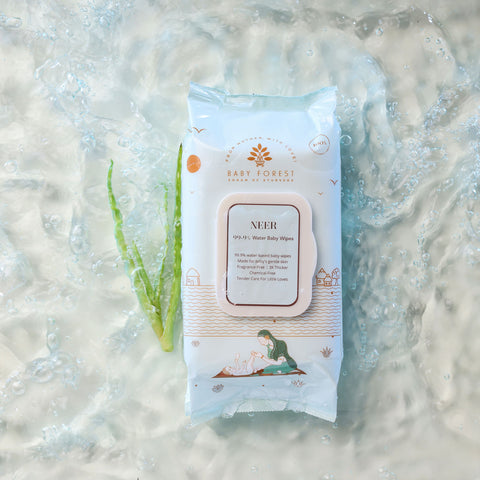
Final Thoughts
The journey of parenthood is full of decisions that shape the health and happiness of your baby. Selecting the right baby wipes is a small yet significant part of this journey. Water wipes, particularly those crafted from ultra-soft bamboo fabric and infused with purified water and aloe vera, offer a safe, gentle, and eco-friendly solution for maintaining your baby's hygiene and comfort.
In embracing water wipes, you are choosing a baby product that aligns with the delicate nature of your baby's skin while supporting sustainable practices. Remember, in the vast sea of choices, the simplest ones are often the best for your baby and the environment.
As you navigate through the early stages of parenthood, let your love and care for your baby guide your decisions. By opting for water wipes, you are ensuring a gentle, pure, and loving touch for your baby's delicate skin, reinforcing your commitment to their health and happiness.
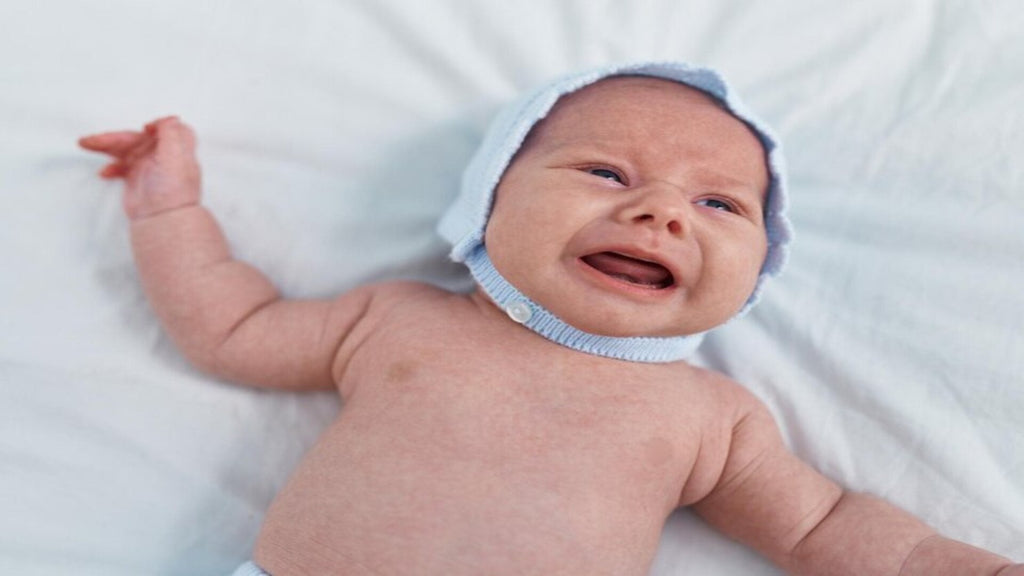
What Causes Colic? A Simple Guide for Parents
Welcoming a new baby into your home is a time of joy and wonder, but it can also introduce a series of challenges, particularly when your little one starts exhibiting signs of discomfort and distress for no apparent reason. This can be a perplexing and exhausting time for new parents. One common issue that could be at the heart of your baby's distress is baby colic. Understanding baby colic, its causes, and how to alleviate its symptoms can transform this stressful experience into a manageable one.
What Is Infant Colic?
Infant colic is a condition characterized by prolonged periods of inconsolable crying or fussiness in a healthy, well-fed baby. It typically begins within the first few weeks of life and may last until the baby is 3 to 4 months old. While the exact cause of colic is not known, it is commonly linked to a mix of digestive system immaturity, gas, hormonal fluctuations, and overstimulation. Recognizing baby colic is the first step towards providing relief for your baby and restoring peace to your household.
Common Causes of Colic
The underlying etiology of colic is still unknown, but various factors are thought to contribute to this condition. These include:
-
Digestive System Immaturity
Babies' digestive systems are still developing after birth, which can lead to indigestion and discomfort. -
Gas
Trapped air during feeding can cause discomfort and lead to colic-like symptoms. -
Hormonal Changes
Fluctuations in certain hormones can cause stomach discomfort and crying spells. -
Overstimulation
Too much sensory input can overwhelm a baby, leading to prolonged crying episodes.
Signs and Symptoms of Colic
Recognizing the signs of baby colic can help you understand when your baby is not just experiencing typical discomfort. Symptoms include:
- Intense crying episodes, often at the same time of day, usually in the late afternoon or evening.
- Clenching fists, arching the back, and tensing the abdominal muscles.
- Reddened face during crying spells.
- Difficulty soothing the baby despite trying various methods.
Coping Strategies for Parents
Dealing with a colicky baby can be exhausting and emotionally draining. Here are some coping strategies:
- Take turns with your partner or a family member to give yourself a break.
- Ensure you're getting enough rest and nutrition.
Soothing Techniques
Several techniques can help soothe a colicky baby:
-
Swaddling
Wrapping your baby snugly can provide a sense of security.
Must Read: The Essential Guide to Perfect Swaddling: Techniques and Tips for New Parents

-
Rocking or swinging
Gentle, rhythmic motion can calm your baby. -
White noise
Sounds that mimic the womb environment can be soothing. -
Warm baths
A warm bath might help your infant relax and stop fussing.
Dietary and Feeding Considerations
Feeding plays a crucial role in managing colic:
- Frequent burping: Helps to reduce gas and discomfort.
- Anti-colic bottles and nipples: These are designed to reduce the amount of air your baby swallows.
- Breastfeeding mothers: Consider your own diet and eliminate foods that may contribute to the baby's gas or discomfort.
The Baby Forest Feeding Bottle has been meticulously designed with the wellbeing of your little one in mind, particularly addressing common feeding issues such as colic and gas. The cornerstone of this innovative bottle is its unique nipple design, which is specifically engineered to reduce the intake of air during feeding. This thoughtful feature minimizes the amount of gas and discomfort your baby may experience post-feed, promoting a happier, more comfortable feeding experience.
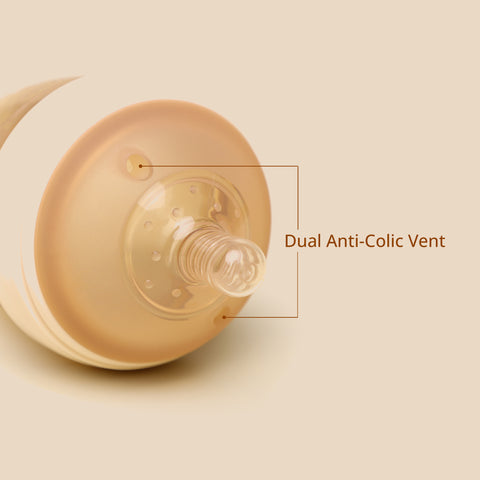
The nipple mimics the natural feel and flow of breastfeeding, ensuring that your baby can latch on easily and feed effectively. This seamless transition between breast and bottle helps to maintain the natural feeding rhythm, which further aids in reducing the likelihood of colic and gas build-up.
When to Consult a Pediatrician?
While colic is generally a temporary phase, it's important to consult a pediatrician if:
- The crying is accompanied by fever, vomiting, or diarrhea.
- The baby is not gaining weight or has feeding difficulties.
- You're concerned about your baby's health and wellbeing for any reason.
Although infant colic can be a distressing condition for both infants and parents, it's important to remember that it is usually temporary and resolves on its own by the time the baby is 3 to 4 months old. Understanding the various causes, recognizing the indications, and employing soothing measures can all help to ease your baby's discomfort. Always consult with your pediatrician to ensure that your approach to managing colic is safe and appropriate for your baby's specific needs. Remember, you're not alone in this journey, and with time and patience, this challenging phase will pass.

How to Pick Safe Essential Baby Care Products
Navigating the vast world of baby care products can be overwhelming for new parents. You want the best for your little one, ensuring every product, from their lotion to their toys, is safe, gentle, and beneficial for their development. This guide aims to simplify the whole process for you, providing you with the knowledge to choose the best baby products, focusing on safety, natural ingredients, and the well-being of your newborn.
Understanding Baby Care Product Safety
The safety of baby care products lies in their ingredients and materials. Go for products that are free from harmful chemicals and dyes, which can irritate delicate skin or cause allergic reactions. Look for certifications and labels that guarantee products are tested and safe for babies. Reading reviews and researching baby products online can also offer insights into their safety and efficacy.
Essentials for a Safe Nursery
Creating a safe nursery goes beyond aesthetics. It includes choosing organic bedding, hypoallergenic mattresses, and non-toxic paints. Ensure that all furniture is sturdy and meets safety standards. Air purifiers can also contribute to creating a clean, safe environment by reducing potential airborne irritants.
Safe Skincare and Bathing Practices
Babies' skin is incredibly sensitive, requiring products that moisturize and protect without causing harm. Natural and ayurvedic baby skincare products, such as baby face cream and baby lotion made with ingredients such as chamomile, aloe vera, and coconut oil, offer gentle hydration. For bathing, opt for mild, tear-free baby shampoo and baby body wash that cleans without stripping natural oils. Always test products on a small skin area first to check for any reactions.

Choosing Safe Clothing and Diapers
Selecting clothing and diapers for your baby involves more than just comfort and design. Choose organic cotton or bamboo fabrics that are soft, breathable, and free from harmful chemicals. When it comes to diapers, consider cloth options or chemical-free disposables that offer high absorbency without risking diaper rash or exposure to irritants.

Safe Feeding Practices
Feeding your baby safely is paramount. Glass feeding bottles offer a reliable alternative to plastic, mitigating the risk of BPA exposure. When your baby progresses to solids, bamboo baby feeding bowls provide durable and non-toxic choices. Bamboo bowls are especially favoured for their eco-friendly and biodegradable qualities, making them a safe choice for your baby and the environment. Remember to sterilize feeding items thoroughly to ensure they remain hygienic for your baby's use.

Safe Playtime Essentials
Toys play a significant role in your baby's development, but choosing safe playtime essentials is key. Look for toys made from natural materials like organic cotton crochet toys or food-grade silicone. These materials are not only safer but are also environment friendly. Stacking toys, soft books, and sensory balls are excellent for stimulating your baby's senses without the worry of harmful substances.
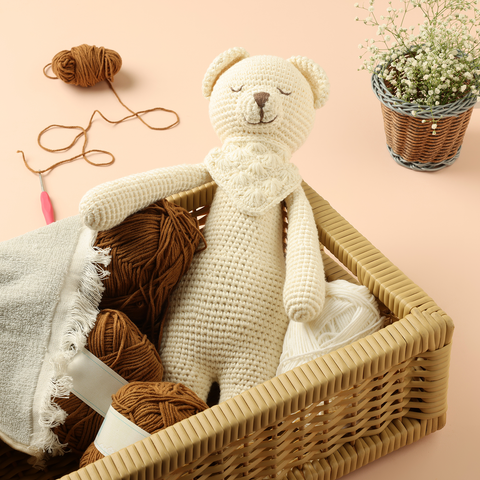
Choosing safe, essential baby care products is a journey filled with love and care. By prioritizing products that are natural, free from harmful chemicals, and designed with your baby's health in mind, you can create a nurturing environment for your little one to grow and thrive. Whether you're purchasing baby skin care products, setting up the nursery, or selecting toys, remember that simplicity and safety go hand in hand. With the correct information and a conscious attitude, you can confidently explore the vast choices of newborn baby products, assuring that you only choose the best for your precious bundle of joy.
Why Water Wipes are a Game-Changer for Babies?
Parenthood is a journey of decisions, each of which is critical to ensure your baby's well-being. One such decision is choosing the right baby wipes, an essential item for every parent's toolkit. In recent years, water wipes have emerged as a game-changer in baby care, providing a gentle, effective solution for cleaning delicate skin. This article discusses why water wipes for newborns are becoming more popular and how they can improve your baby's comfort and health.
What are Water Wipes?
Water wipes are a minimalist answer to baby hygiene, comprising mostly purified water and aloe vera. Unlike traditional wipes, which may contain a variety of chemicals and fragrances, water wipes boast simplicity and purity, making them ideal for newborns and infants with sensitive skin.
As parents become more conscious of the products they use on their babies, the demand for safe, non-toxic options has risen sharply. Water wipes have gained popularity for their commitment to simplicity and safety, offering a no-fuss solution to parents who wish to avoid potential irritants found in conventional wipes.
Benefits of Water Wipes
The primary advantage of using water wipes is their gentleness on the baby's skin. With a composition that mimics the natural cleansing properties of water, they reduce the risk of irritation, making them perfect for daily use. Additionally, the minimal ingredients list means there's less chance of exposing your baby to harmful chemicals.
How can you use them?
The uses of water wipes extend beyond merely cleaning the baby's bottom. They are versatile enough for wiping faces, cleaning up spills, or freshening up while travelling. Their gentle nature makes them suitable for all skin types, providing a one-size-fits-all solution to various cleaning needs.
Tips for Choosing the Right Wipes for babies
When choosing baby wipes, be sure they are safe and comfortable for your baby's sensitive skin. Here are some key points to consider to ensure you're making the best choice:
Alcohol-Free:
Opt for alcohol-free wipes to prevent skin irritation. Alcohol can dry up and irritate the skin, particularly in infants or babies with delicate skin. Alcohol-free wipes maintain the natural moisture balance of your baby's skin, ensuring it remains soft and hydrated.
Hypoallergenic:
Choosing hypoallergenic wipes can significantly reduce the risk of allergic reactions. Hypoallergenic wipes are designed to be mild and contain fewer irritants or allergens that might cause redness, rashes, and other skin disorders. They are ideal for all babies, especially those with sensitive skin or eczema.
Dermatologically Tested:
Look for wipes that have been dermatologically tested. This implies that the wipes have been tested for skin compatibility and are certified as mild and safe for use on sensitive skin. Dermatologically tested wipes provide assurances that the product will cause less irritation or injury.
Soft and Gentle:
The texture of the wipes is also important. Choose wipes that are soft and gentle to the touch. Rough or textured wipes can be abrasive and uncomfortable for your baby, especially with frequent diaper changes. Soft wipes ensure that cleaning your baby is a soothing and irritation-free experience.
Reading Ingredient Labels:
Always check the ingredient list to ensure the wipes are as pure as possible. The fewer ingredients, the better.
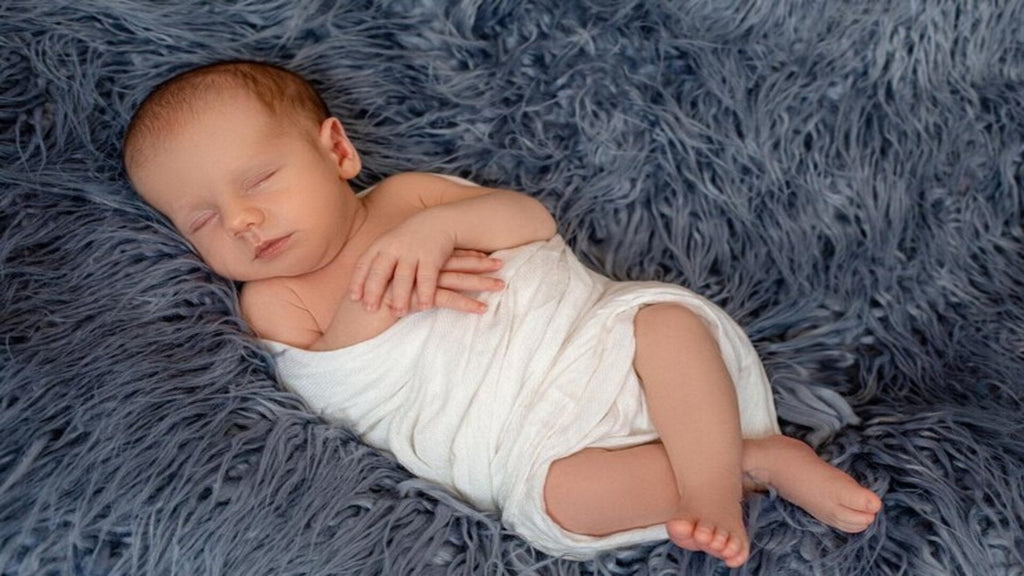
The Essential Guide to Perfect Swaddling: Techniques and ...

Nourishing the New Mother: Ayurvedic Postnatal Care Pract...
The postpartum period is a transformative and delicate time for a new mother. It's a phase that demands care, nurturing, and attention to ensure the well-being of both the mother and her newborn. Ayurveda, the ancient Indian medical system, takes a holistic approach to postnatal care, emphasizing the balance of body, mind, and spirit. This article explores Ayurvedic practices for postpartum care, offering new parents insights into after-delivery care for the mother through time-tested wisdom.
Ayurvedic Principles of Postpartum Care
Ayurveda views the postpartum period as a critical time for healing and rejuvenation. It emphasizes warmth, rest, and nourishment to restore the balance and energy lost during delivery. The Ayurvedic approach to postnatal care focuses on simple, natural practices and remedies to support the mother's recovery and enhance her ability to care for her newborn.
Ayurvedic Nutrition for Postpartum Wellness
Sattvic Foods for Healing:
Ayurveda recommends a sattvic diet to promote purity and balance in the body. Foods like rice, lentils, fruits, and vegetables that are easily digestible support the body's healing process and aid in milk production.
Herbal Infusions and Teas:
Herbal teas made from fenugreek, fennel, and ginger are valued in Ayurveda for their digestive and lactation-supporting properties. These gentle infusions help soothe the digestive system and enhance milk supply.
The Importance of Ghee:
Ghee, or clarified butter, is considered highly nourishing and rejuvenating in Ayurveda. Incorporating ghee into the diet helps improve digestion, promote healing, and provide vital energy post-delivery.
Self-Care Practices
Ayurvedic Abhyanga (Oil Massage):
Regular self-massage with warm oil, known as Abhyanga, can significantly aid in postpartum recovery. It helps relieve stress, improve circulation, and strengthen the body. Sesame oil is often recommended for its warming and nourishing properties.
Herbal Baths and Steams:
Herbal baths and vaginal steams with healing herbs like lavender, chamomile, and calendula can be soothing and promote healing, especially after a cesarean delivery or vaginal birth.
Restorative Rest:
Rest is a cornerstone of Ayurvedic postpartum care. It is essential for the new mother to get adequate sleep and relaxation to replenish her energy and support her body's healing process.
Emotional Well-being
Mindful Practices for Emotional Balance:
Practices such as meditation, yoga Nidra, and gentle pranayama (breathing exercises) can help new mothers manage stress, combat postpartum depression, and maintain emotional equilibrium.
Connecting with the Newborn:
Ayurveda emphasizes the deep bond between the mother and her baby. Skin-to-skin contact, breastfeeding, and spending quality time connecting with the newborn are considered vital for the emotional well-being of both the mother and the child.
Gradual Physical Activity
Introduction to Postpartum Exercise in Ayurveda:
Ayurveda advocates for a gradual return to physical activity. Gentle yoga and walking are recommended to strengthen the body, improve flexibility, and promote overall well-being. These activities should only be started once the mother feels ready and with the approval of her healthcare provider.
The postpartum period is a time of profound change and adjustment. Ayurvedic postnatal care practices offer a compassionate and nourishing approach to support the new mother's journey towards recovery and bonding with her baby. By incorporating principles of Ayurvedic nutrition, self-care, and gradual physical activity, new mothers can experience a holistic recovery, setting a strong foundation for their new role. Embracing these ancient practices can lead to a balanced, joyful, and healthy postpartum period, enriching the experience of motherhood in the most natural and supportive way.
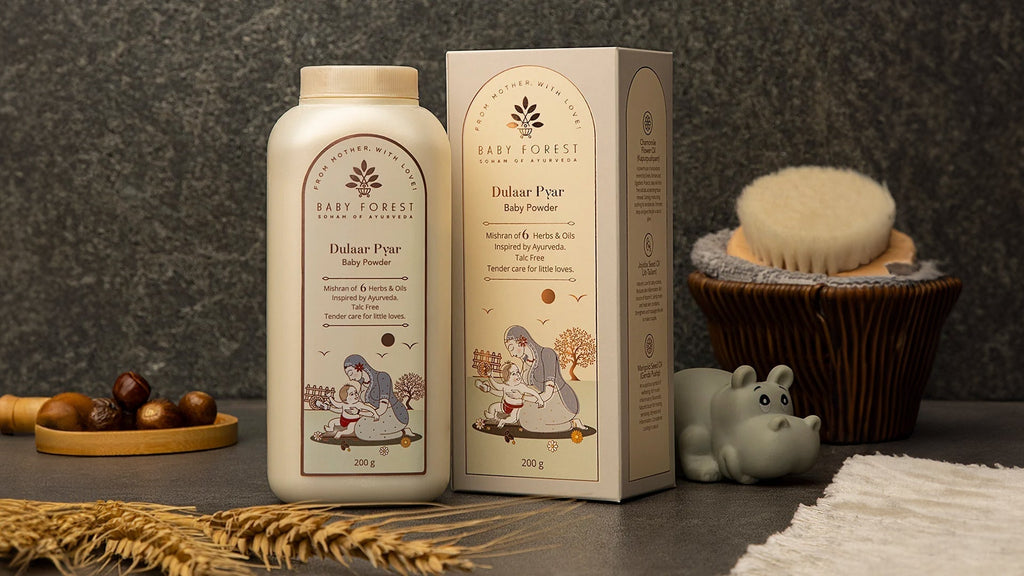
Why Talc-Free Baby Powder Is the Ideal Choice for Infants
When it comes to selecting baby products, parents invariably seek the finest, safest options for their cherished little ones. A significant amount of time is dedicated to meticulously researching and choosing products that promise to be gentle and nurturing for their baby's sensitive skin. Among these products, baby powder has stood as a household staple for generations. Yet, it's crucial for parents to exercise caution, particularly with powders containing talc, as not all baby powders are created equal in terms of safety.
Baby powder, a staple in many households, has come under scrutiny, leading to a shift towards talc-free baby powder. This article delves into why talc-free baby powder is the best choice for your infant, incorporating natural, safe, and gentle ingredients for your peace of mind.
The Shift to Talc-Free
In recent years, the safety of talc-based products has been questioned, prompting parents and manufacturers alike to seek safer alternatives. Talc-free baby powder has emerged as an ideal choice, offering the same benefits without the potential risks associated with talc. But what makes talc-free powder the superior option for infants?
Understanding Talc-Free Baby Powder
Talc-free baby powder is made without talc, a mineral comprised of magnesium, silicon, and oxygen. Instead, it relies on natural and safe alternatives like corn starch, which provides the absorbency and smoothness for which baby powder is known without the associated health concerns.
The Benefits of Going Talc-Free
-
Health and Safety
Talc-free baby powder is gentler on your baby's delicate skin. With no talc as an ingredient, it eliminates the risk of respiratory issues or adverse skin reactions, making it a safer choice for daily use. -
Natural Ingredients
Talc-free baby powders often contain natural ingredients such as chamomile oil, jojoba oil, aloe vera, marigold seed oil, oats kernel, and corn starch. These ingredients not only help in keeping the baby's skin dry but also soothe and nourish it, enhancing the skin's natural barrier. -
Cruelty-Free and Eco-Friendly
Many talc-free baby powders are also cruelty-free, not tested on animals, and are environmentally friendly. This commitment to ethical practices adds an additional layer of appeal for conscientious parents.
Choosing the Best Powder for Your Baby
When selecting a baby powder, looking for talc-free options is just the beginning. The best baby powder for your infant is one that is not only safe but also nourishing for their skin.
-
Chamomile Oil:
It has soothing effects and can help soothe sensitive skin, making it an ideal element in baby powder. -
Corn Starch:
A natural absorbent, corn starch effectively absorbs moisture, keeping your baby's skin dry and comfortable. -
Jojoba Oil:
This oil closely mimics the skin's natural oils, providing moisturization without clogging pores or causing irritation. -
Aloe Vera:
Aloe vera's healing and soothing characteristics make it ideal for treating diaper rash and other skin irritations. -
Marigold Seed Oil:
Known for its anti-inflammatory properties, marigold seed oil can help reduce redness and promote skin healing. -
Oats Kernel:
Oatmeal not only offers comfort but also contains components that can shield the skin and avert irritation.
Tips for Using Talc-Free Baby Powder
-
Apply with Care
To avoid inhalation, sprinkle the powder on your hands away from your baby before applying it to their skin. -
Focus on Moisture-Prone Areas
Apply baby powder to areas that tend to retain moisture, such as the diaper region, underarms, and skin folds. -
Choose Containers Wisely
Opt for powders in shaker bottles or containers that allow for controlled dispensing to minimize airborne particles.
Addressing Common Concerns
With the transition to talc-free baby powders, some parents may wonder about the effectiveness of these natural alternatives. Rest assured, talc-free powders are equally effective in absorbing moisture and preventing diaper rash. The key is in the quality of the formulation and the blend of natural ingredients used.
Choosing talc-free baby powder helps to ensure your infant's safety and comfort. With natural ingredients that soothe, protect, and care for delicate skin, talc-free powders offer parents a worry-free option for keeping their babies dry and comfortable. As you begin on the road of motherhood, choosing products that meet the highest safety and care requirements demonstrates your love for and devotion to your child's well-being. Remember, the best baby powder is one that keeps your baby happy, healthy, and smiling naturally.

A Guide to Creating the Perfect Sleep Space for Your Baby
As new parents, one of the greatest gifts you can give your baby—and yourselves—is the gift of good sleep. Creating the perfect sleep space for your baby is about more than just aesthetics; it's about fostering a safe, comfortable, and soothing environment that promotes sleep. From choosing the right sleeping gear to establishing a cosy bedtime routine, this guide will help you understand the essentials of setting up a nurturing sleep space for your little one. Incorporating key elements such as how to make baby sleep, ensuring the baby's sleeping position is safe, sleep training baby techniques, and the art of swaddling baby for sleep, we aim to provide you with the knowledge to enhance your baby's sleep quality.
Choosing the Right Sleeping Gear
-
Selecting a Cozy Crib or Bassinet
The crib or bassinet is the centrepiece of your baby's sleep space. Look for a sturdy, well-constructed model that meets safety standards. Ensure it has a firm mattress and fits snugly within the crib or bassinet to prevent any gaps. -
Optimal Bedding Choices
Choose soft, breathable materials for the bedding to ensure your baby remains comfortable throughout the night. Avoid overly plush fabrics that can overheat or pose a suffocation risk. -
Wool Blankets
Wool blankets can keep you warm in winter but trap too much heat in summer. They are great at controlling temperature. Ensure the baby blanket is lightweight and breathable. -
Mustard Pillow
Head shaping mustard pillow can be a great addition since it helps with flat-head syndrome prevention by providing gentle support to distribute the baby's head pressure evenly.
Setting Up a Comfortable Sleep Zone
-
Arranging the Crib or Bassinet
Place the crib or bassinet in a quiet corner of the room, away from windows, heaters, and any cords. This positioning helps in creating a calm, undisturbed sleep area. -
Ensuring Proper Ventilation
Good air circulation is crucial for a comfortable sleep environment. Ensure the room is well-ventilated, maintaining a room temperature that is neither too hot nor too cold.
Creating a Relaxing Sleep Atmosphere
-
Soft Lighting
Use soft, dimmable lighting in the sleep space to help soothe your baby to sleep. Harsh lighting can be stimulating and disrupt the sleep process. -
White Noise or Gentle Sounds
White noise for newborns or other soft, relaxing sounds can be used to block out distracting stimuli and provide a peaceful sleeping environment. Devices designed for baby sleep are widely available and can be very effective.
Dressing Your Baby for Sleep
-
Choosing Appropriate Sleepwear
Select sleepwear that's appropriate for the room's temperature, opting for lightweight, breathable fabrics that won't overheat your baby. -
Swaddling Techniques
Swaddling can provide comfort and security, helping babies to sleep more soundly. Learn safe swaddling techniques to ensure your baby's hips and legs can move freely and avoid overheating. Use a super soft bamboo muslin fabric for your baby’s swaddle because it is lightweight and breathable bamboo muslin fabric lets your baby regulate their body temperature, promoting a comfortable and restful sleep.
Nighttime Routines for a Cozy Sleep Space
-
Establishing Consistent Bedtime Rituals
A consistent bedtime routine can significantly aid in baby sleep training efforts. Bathing, reading, or gentle massages can signal to your baby that it's time to wind down. -
Creating a Sense of Familiarity
Consistency and familiarity help babies feel secure. A predictable sleep environment and routine can make bedtime a much smoother process.
Transitioning to a Crib
As your baby grows, transitioning from a bassinet to a crib is a natural step. Make this transition gradually, starting with naps in the crib to familiarize your baby with the new sleep environment.
Keep in mind every baby is different, so what helps one baby sleep might not help another the same way. Be patient, and don't hesitate to adjust your approach as you learn what makes your baby sleep most peacefully. With love, care, and attention to detail, you can create a haven that supports your baby's sleep needs, laying the foundation for healthy sleep habits that can last a lifetime.
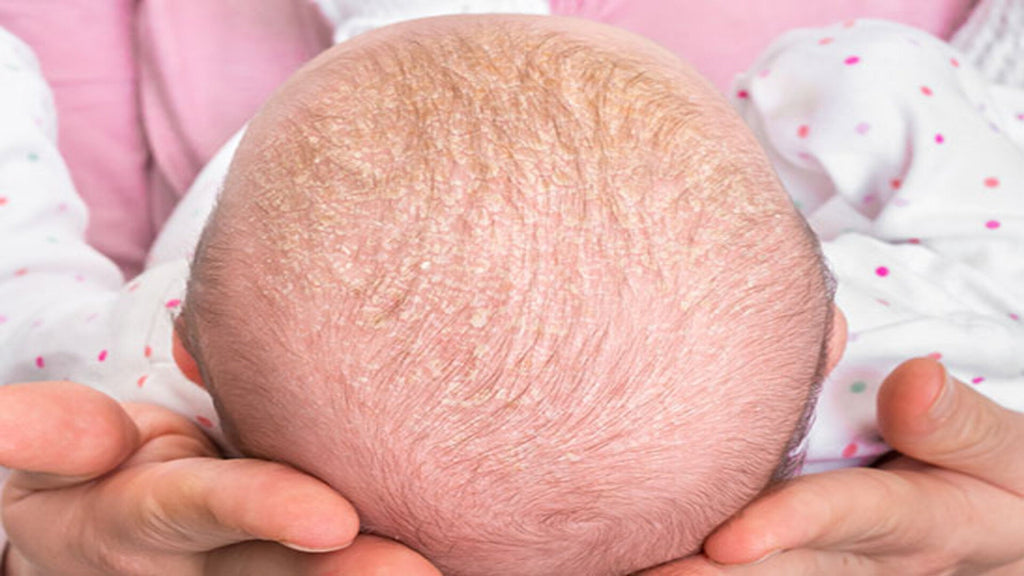
Dealing with Cradle Cap: Causes, Treatment Options, and P...
One common puzzle that many new parents encounter is the cradle cap. This harmless but often perplexing condition can leave tiny scalps looking a bit flaky. In this article, we'll understand cradle cap, its causes, treatment options, and proactive measures parents can take to keep their little one's scalp healthy and happy.
What is a Cradle Cap?
Cradle cap, scientifically termed seborrheic dermatitis, is a prevalent skin condition that commonly manifests in infants within the initial months of their lives. This condition is typically identified by the presence of yellowish, greasy scales on a baby's scalp, making it look like a mild case of dandruff. Though a cradle cap isn't itchy or painful for your baby, it can understandably cause concern for parents.
A cradle cap tends to make its debut in the first few weeks of a baby's life and can persist for a few months. While it might be a bit unsightly, the good news is that the cradle cap in infants is temporary and usually resolves on its own without causing any long-term issues for your little one.
Cradle cap tends to impact approximately 10 per cent of newborns within their first month, with the prevalence soaring to 70 per cent by the time they reach three months old. Surprisingly, the occurrence diminishes significantly to only 7 per cent in infants aged 1 to 2 years.
Causes of Cradle Cap
-
Sebum Overproduction
One of the primary causes of cradle caps is the excess production of sebum, a natural oil that the skin produces. In newborns, the sebaceous glands can go into overdrive, resulting in an excess of this oily substance. When dead skin cells mix with sebum, it results in the characteristic yellowish crust seen in the cradle cap. -
Fungal Involvement
The presence of a fungus known as Malassezia, which resembles yeast, is considered to be another factor that contributes to the problem. While harmless, this fungus can exacerbate the production of sebum and contribute to the development of cradle caps.
-
Environmental Factors
Environmental elements, such as alterations in weather conditions or exposure to abrasive shampoos, can contribute to the onset or exacerbation of cradle cap. Parents can take proactive measures to handle the condition by comprehending and addressing these factors effectively.
Treatment Options for Cradle Cap
Gentle Shampooing
A simple yet effective way to manage cradle caps is through gentle shampooing. Opt for a mild, organic baby shampoo, using warm water to soften the scales before gently massaging and rinsing the scalp.

Scalp Massage
Gently massaging your baby's scalp with your fingers using a natural hair massage oil can help loosen and lift the scales. Massage with a natural and baby friendly hair oil not only aids in the removal of cradle caps but also provides a comforting and bonding experience for both parent and baby.
Brushing or Combing
Using a soft baby brush or comb, carefully brush through the baby's hair to remove loose scales. Be gentle to avoid irritating the scalp, and always ensure the tools are clean and safe for your little one. The Sunehere Resham baby comb is a wooden hairbrush made of natural elements with super soft bristles for infants and kids. It gets rid of the cradle cap and releases natural oils in the baby’s hair and skin without damaging or scratching.

Natural Remedies
For parents who prefer natural remedies, applying a small amount of coconut oil or almond oil to the affected areas before washing can help soften and loosen the scales. Always test a small patch to ensure your baby doesn't have any adverse reactions.

Choosing Organic Baby-Friendly Products
Opting for organic baby products can make a significant difference in preventing and managing cradle caps. Look for shampoos and skincare items with natural ingredients, free from harsh chemicals that could potentially worsen the condition.
When to Consult a pediatrician
While cradle caps are generally harmless, consult your pediatrician if you notice persistent redness or inflammation or if the condition spreads beyond the scalp. In rare cases, a prescription medication may be recommended.
A cradle cap may be a temporary visitor on your baby's scalp, but understanding its causes and treatment options can empower you as a parent. Embrace a gentle and organic approach to your baby's skincare routine, promoting a healthy scalp from the start. By incorporating these proactive measures, you can ensure that the cradle cap becomes just a fleeting moment in your parenting journey, leaving you with a happy and content baby.



